How to visit Ostia Antica (and why you should add it to your Rome itinerary)
Discover how to visit Ostia Antica from Rome with this practical travel guide packed with information and tips on how to get to Ostia Antica, what to see and why you should add this wonderful day trip to any Rome itinerary.
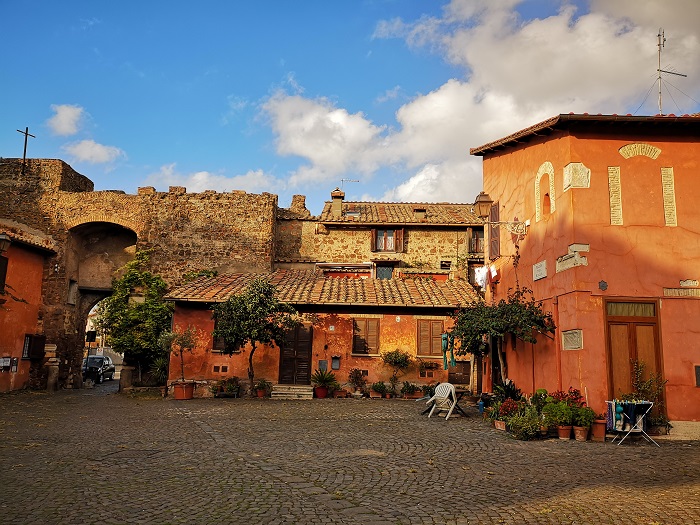
One of my favorite places in the whole of Italy and one that is easy to reach from Rome for an afternoon off the beaten path , is gorgeous Ostia Antica.
Located in the greater Rome metropolitan area and only 30 minutes form the city center, Ostia Antica is the old port of Rome and is a place of great beauty and historical significance.
here you have a large archaeological park dating back to Roman times and a small medieval ‘borgo’ with a lovely castle and a main square of immense charm.
This is my full travel guide to Ostia Antica from Rome. Safe travels!
Table of Contents

What is Ostia Antica?
Ostia Antica is a beautiful archaeological site immediately outside of Rome. It dates back to ancient Roman times and lies just at the mouth of the Tiber, where the rives merges with the Thyrrenian sea.
This location is the key to understanding the history of this place: Ostia Antica is the ancient port of Rome and for centuries was an important trade center in the area.
Is it worth visiting?
If you have been sightseeing around Rome you might be wondering if a trek to one more site with Roman ruins is worth it and my response in this case unequivocal: Ostia Antica is so worth you you may enjoy it even more than Rome itself!
the big thing about Ostia is that is mixes incredibly well historical relevance and natural beauty. The park is a vast open air area and has stunning ruins dotted with tall pine trees standing tall against the blue Italian sky.
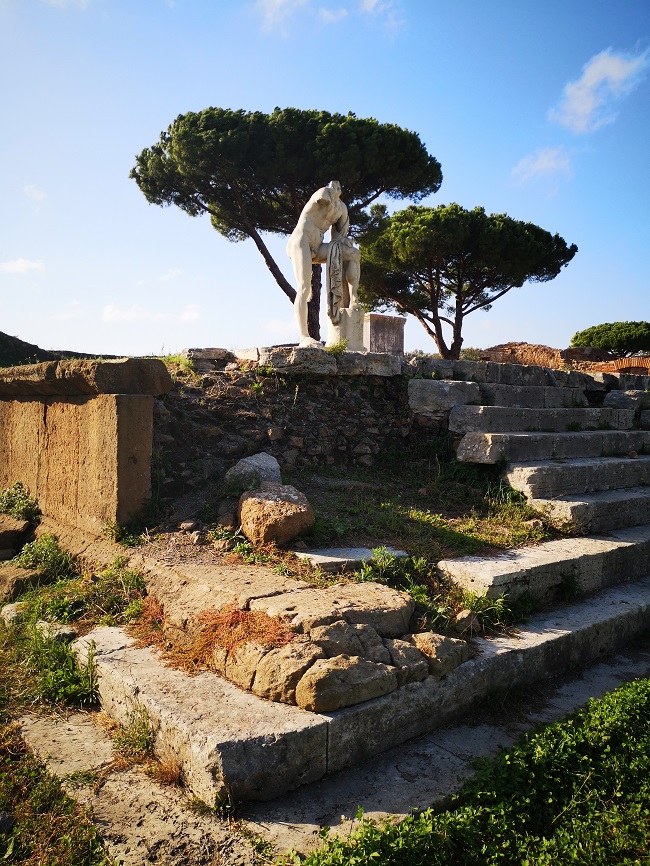
The crowds haven’t discovered Ostia Antica yet and while you do get tourism here, you are likely to find yourself walking almost alone along the ancient streets of this beautiful town.
Less grand than Pompei, Ostia gets often compared to its bigger sister town and in some way it is easy to see why. Both are well preserved Roman town and both give great insight on how life must have developed in ancient times.
However, Ostia has a much slower pace than Pompei and a day here is a mix between a sightseeing opportunity and a day outdoors, something you are likely to crave after the busy streets of Rome city center.
What there is to see?
There are two main sites to see in Ostia Antica: the archaeological park and the ‘borgo’. The two lie beside each other and you can walk between the two in less than five minutes.
They are both served by the same train station so the travel information below apply to both.
It is possible to visit both Ostia Antica park and borgo in one afternoon.
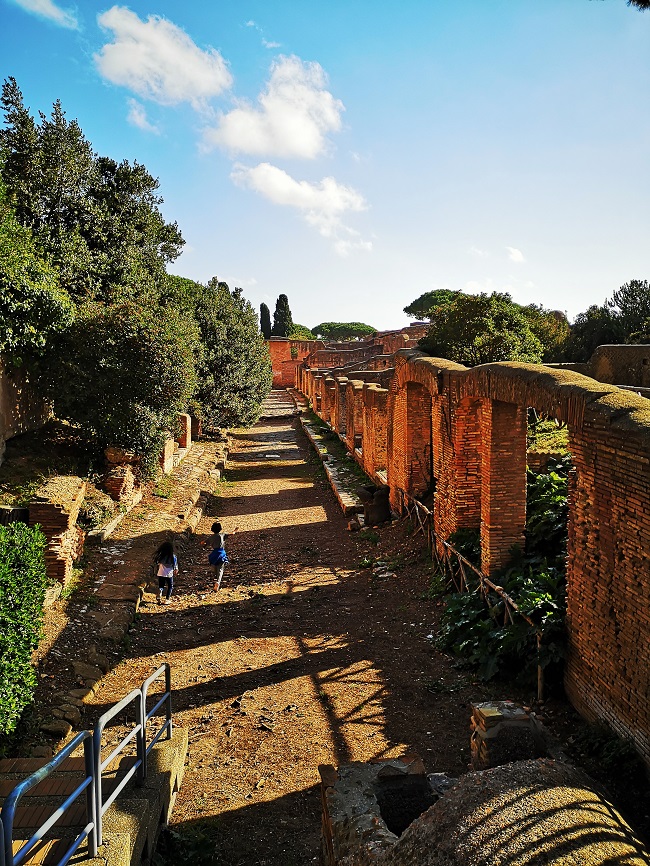
How to get to Ostia Antica from Rome
Ostia Antica is connected to Rome city center by a frequent commuter train. The train leaves Roma Ostiense station at regular intervals (up to 12 time per hour) or so and the ride takes approximately 30 minutes.
This train is part of the Rome public transport network ( you can read our full guide to getting around Rome here ) and you need the same ticket that yo would use on the metro of bus. The cost of one ride is 1.50 euro.
Like on buses and metro kids under 10 go free.
The train brings you to the small train station called ‘Ostia Antica’ and from there reaching the park is easy. As you exit the station the park is right in front of you, on the other side of the road.
To facilitate crossing of this big Roman artery there is a bridge which you get to climb buy a set of stairs.
The bridge is the quickest way to reach the entrance to the archaeological park but it is sadly impossible to access if you have any mobility issues.
If that is the case, you need to head to your right and take the longer route via the borgo (it takes a few minutes to walk that way) which is flat.
How to visit Ostia Antica archaeological park
The entrance to the archaeological park is served by a small ticket office and bookshop. Here you can buy your tickets for the day (advance purchase is not necessary) and you can also pick up the audio guide.
The park is open every day except Mondays, New year and Christmas day. The opening times depends on the season: you can check official schedule here (in Italian)
Taking the audio guide is worth it as in Ostia you do not have info panels explaining what the ruins you are looking at used to be.
While some such as the theater and the thermpilum do have brief info at their entrance, the vast majority of sites are unmarked, making the place beautiful yet hard to grasp without a guide of some sort.
The best way to visit Ostia Antica is to come equipped with a good pair of walking shoes and get hold of the audio guide and the (free) map available at the ticket office.
For the best experience, I recommend you devote a few hours to the park and take a break at the park cafe and restaurant before venturing to the farthest part of the park.
The cafe is pleasant and well serviced and it is a good place for a rest. Here you have snacks, light meals, toilet facilities and agood bookshops for loal guides and souvenirs.
What to see in Ostia Antica and park layout
Once you are in, the parks opens up in front of your eyes. Coming from the train station you find yourself on the ‘Decumanus maximum’, Ostia Antica’s ancient main street and you find archaeological ruins on both sides of you.
Along the decumanus you will see the impressive Ostia Antica theater, some religious buildings and the ruins of the many shops and warehouses that were at the heart of this commercial city.
This is probably the most impressive part of the whole of Ostia: the theater can be easily accessed and you can see it both from the spectators seats and from the main stage. The view from both is spectacular!
Behind the theater you find access to the excellent local museum and the park’s cafeteria and bookshop
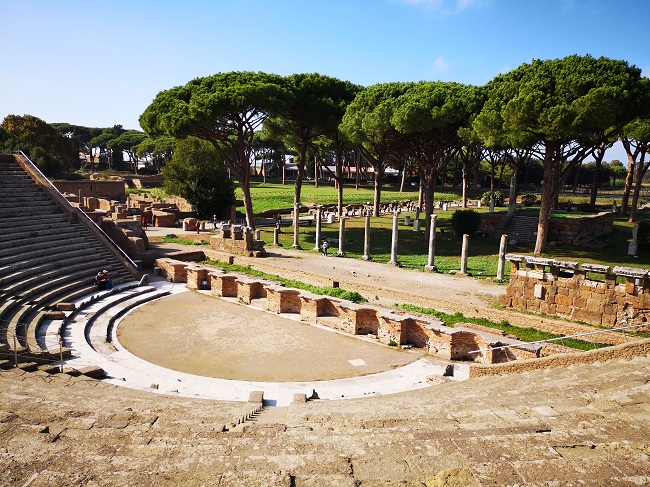
Farther along the decumanus you will then reach the forum, which used to be the center of administrative affairs.
This is a really interesting area to visit and it is worth taking the time to wander in the smaller streets to the side of the decumanus: here you can see, among other things, the thermopilum, an ancient Roman cafe / restaurant that will make you realize how, when ti comes to enjoying food and socializing. ancient Romans were as close to us as it can get!
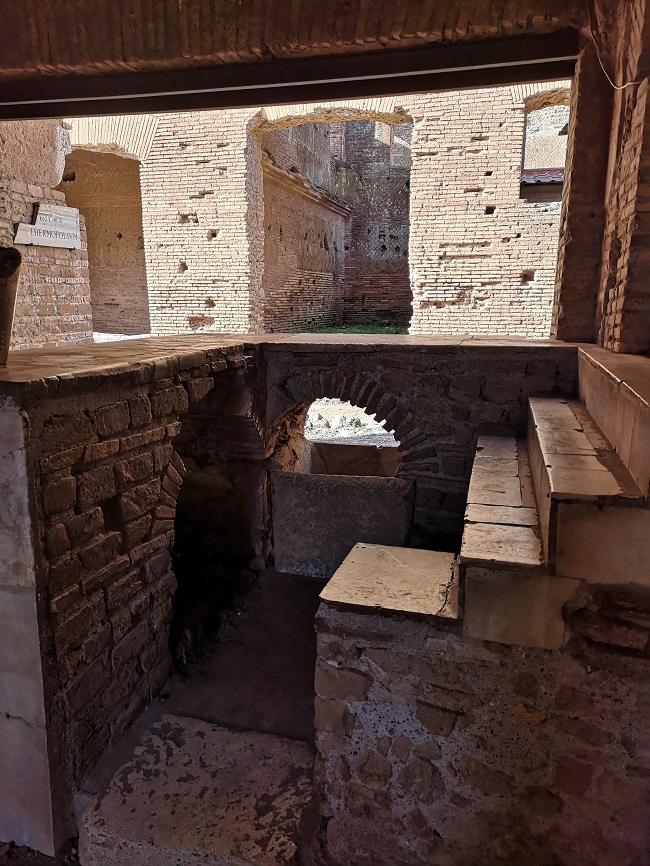
Farther again the area of ‘Via della Foce’ preserved some beautiful mosaics and thermal baths and finally, at the very end of the park the area of Porta Marina is where we can still see the richest Roman Domus and thermal baths infrastructures.
This last part of the park is beautiful and historically significant due to the various construction techniques used in its buildings. I personally love this part of the town as I find the mosaics truly breathtaking! This is one of the not many place where it is possible to admire ancient mosaics in Rome .
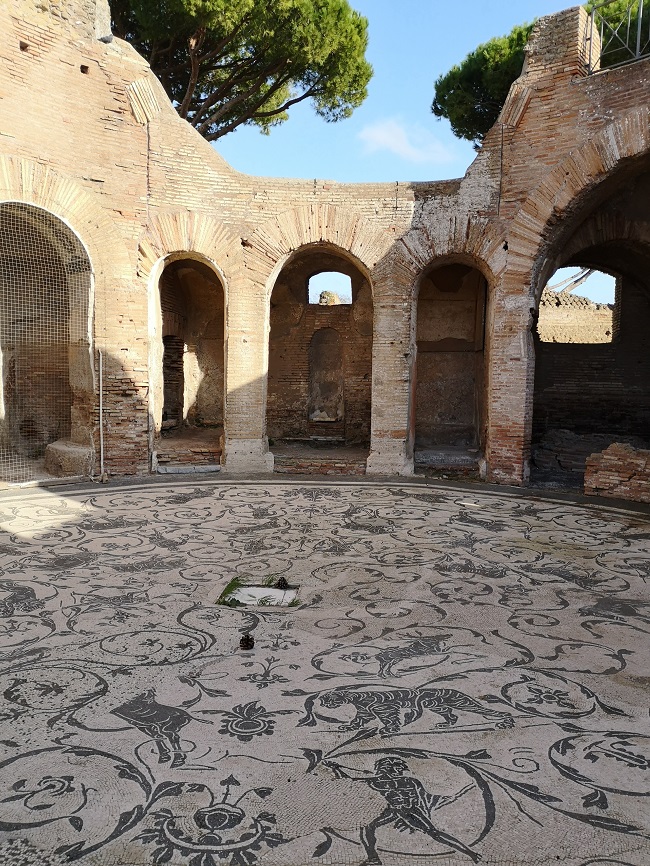
A brief history of Ostia Antica
Archaeological remains suggest Ostia Antica dates back to IV century BC and was born as a castrum (military fortification) to control the mouth of the river Tiber and therefore access to Rome via water.
Over the course of the centuries Ostia developed into a large and important city: its original perimeter of walls was replaced by a bigger one in the first century and 3 entrances to the city remain: Porta Romana, Porta Marina and Porta Laurentina.
Ostia grew in importance for a centuries and reached its peak in the I and II century AD.After this time, the city went through a slow decline and it looks like it was abandoned between the IX and X century: at this time, the population left the ancient city and moved farther East in the medieval ‘borgo’ of Gregoriopoli.
The medieval Borgo of Ostia Antica
Outside Ostia Antica’s archaeological park,only 5 minutes down the road from the park and train station, lies the second gem of this area: Ostia’s ancient borgo.

The borgo is nothing more than a small square developing around the impressive Ostia castle and it is one of the most charming places you will encounter in Rome and not only.
The small square is traffic free and enclosed by the castle, a church and a series of small buildings with cascading flowers and colorful walls.
the borgo can be visited in a matter of minutes but it is worth planning a bt of time here and especially sty for dinner.
Just off the square, you will find a few tables on the street, dressed with red and white table cloths: they belong to a small family restaurant and if you can have a meal here, it is likely to stay as one of the most relaxing and pleasant of your whole stay in Rome!
I hope you enjoyed this post and it helped you answer the question: how to visit Ostia Antica from Rome?
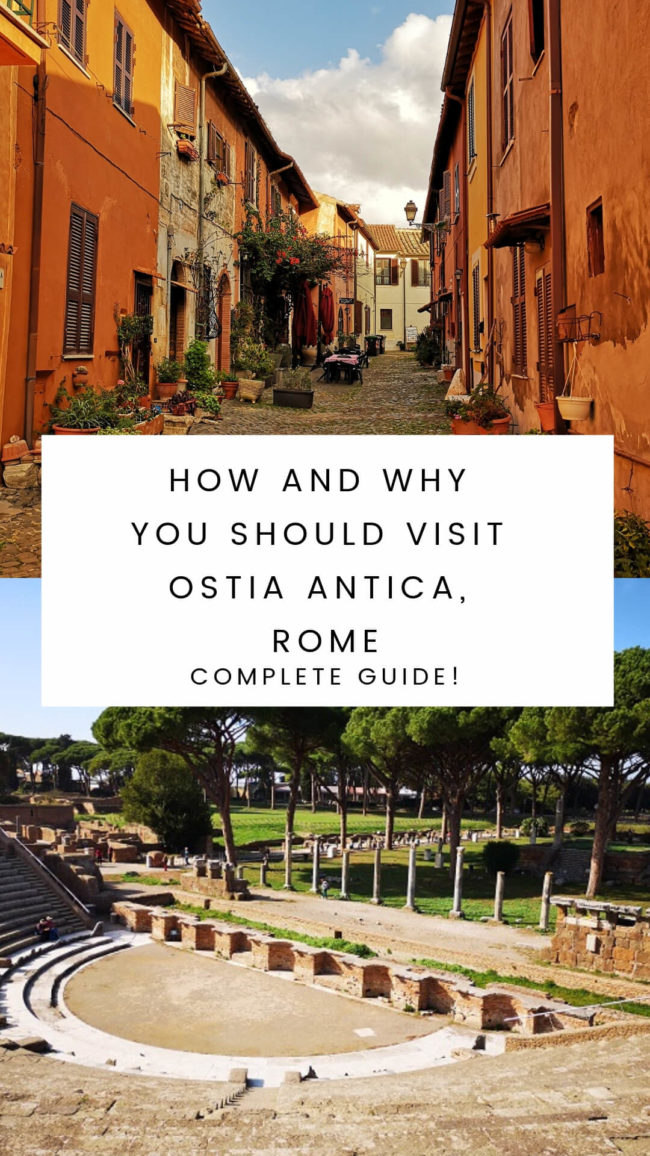
My name is Marta, I am a travel-loving mama born and bred in that messy, wonderful, infuriating, awe-inspiring unbelievably beautiful city that is Rome. A classics graduate and professional travel blogger, on this site I share my insider tips to help you plan your dream trip to Rome, Italy.
Rome tips for beginners: complete Rome guide for first time visitors (by a local!)
A family tour of rome fun for all ages: tapsy tour review, you may also like, 50 free things to do in rome you’ll..., american breakfast in rome: 5 delicious addresses you’ll..., best things to do with kids in rome..., the 29th of june in rome: what you..., the best things to do in rome at..., villa borghese gardens: how to visit, best things..., outdoor swimming pools in rome you’ll love this..., how to see rome in two days: perfect..., fun and interesting facts about the colosseum for..., christmas markets in rome you will love this..., privacy overview.

- Things to do
- Day Trips from Rome
Ostia Antica
Once the harbour city of ancient Rome, Ostia Antica is now a vast archeological site, located near the city of Rome. The town was abandoned and buried for over ten centuries until it was rediscovered.
Nowadays, Ostia Antica is a large archaeological site. Located just 19 miles (30 km) west of Rome and on the River Tiber. During ancient Rome, it was one of the most thriving cities in the region thanks to its status as Rome’s harbour city.
After the collapse of the Empire, the city fell into decadence, was eventually abandoned and remained untouched and magnificently preserved for centuries.
Ostia Antica became Rome’s main seaport during the Roman Republic (509 BC – 27 BC) and the city was largely improved by Julius Caesar and Tiberius, during part of the Roman Empire. Nevertheless, the Romans slowly began to depend on other ports, meaning that the commercial activity in Ostia slowed down until it fell into decay during the fourth century AD.
During the same period, the inhabitants of Ostia were hit by malaria and many fled to save their lives. This is how a city which had once a population of 100,000, was abandoned and turned into a forgotten port during several centuries.
The city is relatively well preserved, but not as well as Pompeii or Herculaneum , where the cities were completely buried under volcanic ash and mud.
What to see
The archaeological site still houses the remains of most of the city’s buildings before it was abandoned.
Ostia’s main arterial street, called Decumanus Maximus in Roman cities, cuts through the whole city, while the arcades on both sides of the street show the houses and shops which once thrived here. There are also taverns, inns, shops, public baths and a large reconstructed theatre, which is still used during the summer.
The harbour city had a very cosmopolitan population, visible thanks to a Jewish synagogue, a Christian Basilica and the 18 temples dedicated to the Persian god Mithra.
Less interesting than Pompeii
If you aren’t going to visit Pompeii or Herculaneum, then Ostia Antica is an archaeological site well worth visiting in which it is possible to imagine how the city’s inhabitants lived centuries ago. However, compared to Pompeii or Herculaneum, it is less impressive and less well preserved.
If you visit the site during the summer, we recommend taking water and a hat to protect you from the sun, since there is little shade in the site.
Directions from Rome
Unless you have a car or wish to book a guided tour, Ostia Antica is very close to Rome and is easy to get to by public transport.
To get there using public transportation take the metro (line B) and get off at Piramide. Here, take the Roma Lido commuter train to Ostia Antica. Once at the station, all you have to do is follow the crowd. It is a 10-minute walk away.
The train to Ostia costs € 1.50 ( US$ 1.70) (like any other one-way journey ). Since you are going to use quite a lot of public transport, you might want to buy a day pass.
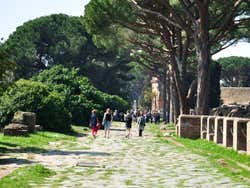
19 miles (30 km) from Rome
Tuesday – Sunday: 8:30 am – 4:30 pm, 5:15 pm, 6:30 pm or 7 pm (depending on the season) Closed: Monday, 25th December, 1st January
Adults: € 18 ( US$ 19.80) EU Citizens aged 18 - 25: € 2 ( US$ 2.20) Children under 1 metre and people with disabilities: free 25th April, 2nd June and 4th November: free
Ostia Antica Half-Day Tour from Rome € 50 ( US$ 55.10)
Nearby places
Rome Fiumicino Airport (5.6 km) Basilica of St. Paul Outside the Walls (19.2 km) Trastevere (20.4 km) Janiculum Hill (20.7 km) Basilica di Santa Maria in Trastevere (21 km)
You may also be interested in
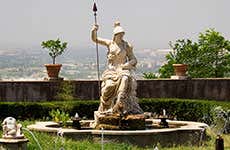
Villa d'Este
Villa d’Este is a sumptuous Renaissance dwelling located in the outskirts of Rome. It stands out for its beautiful gardens and charmingly decorated rooms.

Pompeii was an ancient Roman city near modern Naples that was buried by the great eruption of Mount Vesuvius in 79 AD.
Home / Opening Hours & Tickets / Free & Reduced Admission /
Free Admissions, Reductions and Discounts
Free admission.
- EU citizens younger than 18 years old
- Disabled visitors and their carer
- Non-EU citizens on a condition of reciprocity (children younger than 12 years old must be accompanied by an adult)
- EU licensed guides , if leading a group and after showing valid license
- EU licensed guide interpreters , if accompanying a guide and a group, after showing valid license
- MiC (Italian Ministry of Culture) employees
- ICOM (International Council of Museums) members
- EU students groups from public and private schools, accompanied by their teachers, showing at the ticket desk an official list of partecipants, signed by the head teacher
- Students of higher learning courses at Ministerial Institutes (Istituto Centrale per il Restauro, Opificio delle Pietre Dure, Scuola per il Restauro del Mosaico)
- EU Professors and students attending the Academy of Fine Arts: free admission is allowed after showing current year’s certificate of registration
- EU Professors and students enrolled in BA, MA, post-graduate, PHD courses at the Faculties of: Architecture, Conservation of Cultural Heritage, Educational Sciences, Humanities specialised in Archaeology or Art History. Free admission is allowed after showing current year’s certificate of registration or suitable document
- Art History High School teachers , after showing a suitable document
- Licensed Journalists : free admission is allowed after showing the personal professional license [doc 3017]
- For study and research purposes : upon presentation of appropriate supporting documentation provided by educational and cultural institutions, universities or government departments, indicating the period of validity of the request.
- EU licensed Tour Guides
- Full-time and temporary teachers . Temporary exhibitions and special events, not included in the general admission ticket, can be accessed by paying the related fee through the “Carta del docente” (cartadeldocente.istruzione.it)
- Study and research purposes
- Volunteers organizations with an agreement with Ministry departments
- Ministry Honorary Inspectors and Curators
- Carabinieri Command for the protection of Cultural Heritage
- C.C.R.O.M. members
Reduced admission
- 2 € for 18-25 years old EU citizens
- 20% discount for Italians resident abroad , upon presentation of the “Discount card” issued by the Ministry of Foreign Affairs and International Cooperation, with holder’s signature and ID card.
- Free and reduced admission to Swiss Confederation citizens (as per DM 20 aprile 2006, n.239, co.3, lett.e and co.6, art.1).
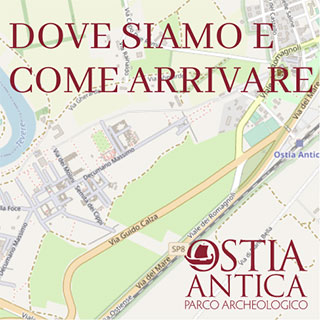
Getting here
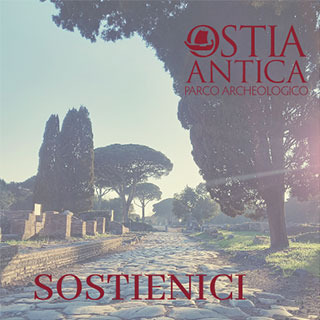
Percorsi tematici
WebGIS NADIS
Nuovo archivio disegni
Educational panels and Interactive maps

Servizi educativi
Biblioteca Ostiense - Catalogo online
- Organisation positions
- Non-permanent staff
- Photo Archive
- Exhibitions and Loans Department
- Restoration Department
- Anthropology Department
- Personnel Department
- Promotion Department
- Communication and Public Relations Department
- Fundraising Department
- Laser Scanner Project
- Vincoli Office
- Technical Office
- Territorial protection
- Boacciana Tower
- Banks of the Tiber
- Salt building (Casone)
- Seaside villas (Procoio)
- St. Herculanus’ Church
- Necropolis and basilica (Pianabella)
- Laurentina Necropolis
- The Ostiense Museum
- Julius II Castle and Ostia antica Hamlet
- Monte Giulio archaeological site
- Museum of Roman ships (Fiumicino)
- Tombs in “ex O.N.C.” area
- Temple of Isis
- St. Hippolytus Basilica
- Accessibility
- Necropolis of Porto
- Imperial Harbours of Claudius and Trajan
- Museum of Ships of Fiumicino
- Integrated tickets and Fidelity card
- Free & Reduced Admission
- Didactics exhibition
- School-to-work 2018-19
- School-to-work 2019-20
- School-to-work 2020-21
- School-to-work 2021-22
- School-to-work 2023-24
- “Little Ciceros” project
- First Mascot
- Public Relations Department
- Service Charter
- General panels
- The Via Ostiensis Necropolis
- The area serving the river
- The area of the theatre
- The area of the eastern cults and the Porta Laurentina district
- The Via Laurentina necropolis
- The Central Area and the Official Complexes
- The Residential Districts of the Upper-Middle Class
- The Market District
- The Coastal Districts and the Maritime Domus
- The Ostia's Trastevere
- The marbles
- What is Art Bonus
- Tax benefits
- How to donate
- Ostia, step by step, a journey to travel together

Archaeological Park of Ostia antica © 2017-2024 - All Right Reserved - C.F. 97900080587
Legal Notes | Accessibility Notes | Privacy | Credits
Discovering Ancient port of Rome: Ostia Antica Tour.
Discover the wonders of Ostia Antica: Guided tour through Ancient Rome's harbor city.
Wide range of tours offered every day , with FreeTourRome!
Unlock the Mysteries of Ostia Antica: Embark on an Unforgettable Journey Through Time.
Nestled just a stone's throw away from Rome lies the ancient harbor city of Ostia Antica, a hidden gem waiting to be discovered. With our expertly guided tour, you'll delve deep into the secrets of this captivating archaeological site, where echoes of ancient life still resonate..
Why Book This Tour?
- Because we offer more than just a glimpse into the past – we provide an immersive experience that brings history to life. Skip the long lines and let our knowledgeable guides lead you through the well-preserved ruins, unveiling the stories of merchants, sailors, and everyday Romans who once thrived here.
- From the grand amphitheater to the intricate mosaics and bustling streets, each corner of Ostia Antica tells a tale of the city's vibrant past. Don't just visit history – live it. Book your Ostia Antica tour today and embark on an adventure that will leave you in awe of the wonders of ancient Rome.
This tour includes: Skip the line tickets - Train Ticket (Round trip) - Small groups

Discover with peace of mind - Book today and enjoy the flexibility to cancel or modify your plans for FREE.
**The colored ''book now'' buttons explained:
Green = Tour is Available / Orange = Only few places Available / Red = Tour Not Available / Purple = Discounted price
City tour, Rome
Recommended by 92% of travellers

Starting times: 9:30 - 12:30 - 15:00
Inside Pantheon tour
with Gelato tasting.

Starting times: 10:00 or 10:30 - 15:00 or 17:30
More info & Book
Ghost tour Rome.
with Capuchin Crypt Ticket.

Starting time: 17:00 - 5 PM
Jewish ghetto & Trastevere tour
Recommended by 94% of travellers
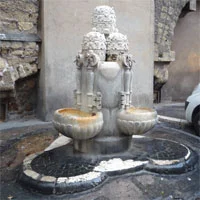
Starting times: 10:30 - 15:30 - 17:30
Ostia Antica tour
Small groups.
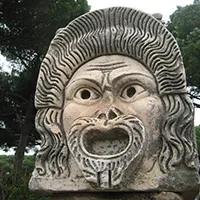
Starting time: 08:30 AM
Colosseum, Roman forum by night
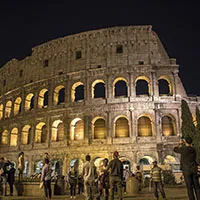
Starting time: 18:00 - 6 PM
Colosseum, Roman forum, Palatine Tour
Yes , It will be also inside the Colosseum
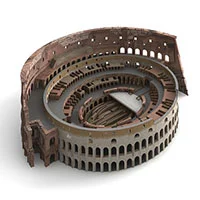
Starting times: different time slots
Evening tour, Rome
Including Trevi fountain
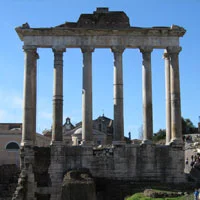
Starting times: 17:00 or 18:00
Vatican & Sistine chapel Tour
Including skip the line ticket.

Starting times: different time slots.
Vatican night tour
Including Spanish steps

Starting times: 19:15 or 20:15
Capuchin Crypt & Pantheon tour
Yes , It will be also inside the Pantheon
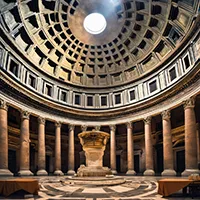
Starting time: 17:00 - 5PM
City & Pantheon tour
Including entry ticket Pantheon.

Starting times: 10:30 or 11:00 16:00 or 17:00
Free tour Rome, Pic of the day
+393758926136
- Quick links Partner login Blog Questions & Answer
- Useful info About us Contact Terms & conditions
- Manage My reservation Print my Booking

How To Visit Ostia Antica, Rome
This post may contain affiliate links. This means that for any qualifying purchase you make through one of my links, I may earn a small commission, at no cost to you. For more information, check out my disclosure .
If you are a fan of history and archeological sites, there is no doubt that you should visit Ostia Antica while in Rome. An easy day trip from the Italian capital, thanks to its location right at the mouth of the Tiber River (which has moved since!), this used to be Rome’s ancient harbor – it was literally where all the goods that went around Rome went through; and at its peak it was actually more important than Pompeii.
Only a portion of the site has been fully excavated – in fact, if you visit you will see that archeologists are still working on it!
A proper visit to the site will give you plenty of insights into the every-day, social, cultural and economic life of Rome. Need more reasons to visit Ostia Antica? Here’s one: although the city had a prominent role in Roman history, it’s yet to become a popular tourist attraction – so it’s a nice place to go to escape the crowds of Rome. Furthermore, it’s actually an incredibly pleasant place to visit even on hot summer days, as it’s beautifully immersed in a forest of pine trees.
If you are curious to learn more about Ostia Antica and looking for information on how to plan your visit, you are in the right place. Continue reading to learn everything you need to know for a smooth experience.
Make sure to read my post The Best Day Trips From Rome .
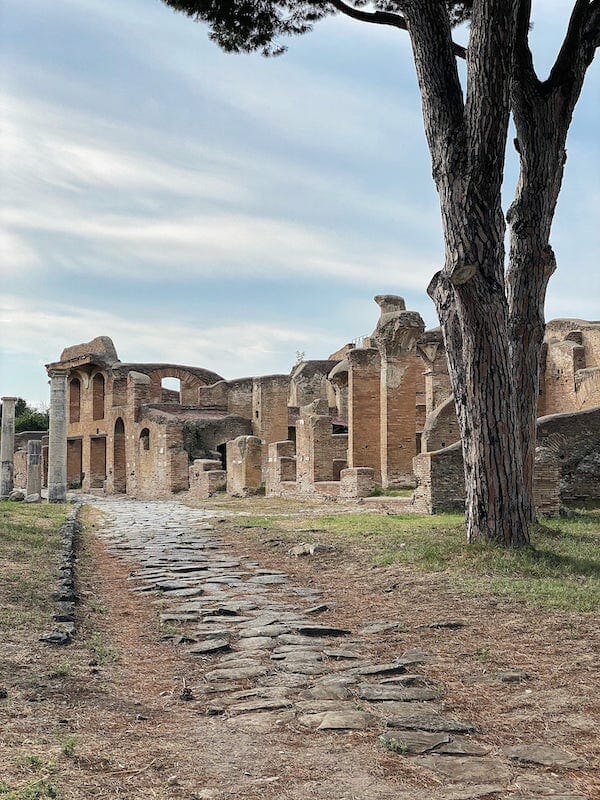
Table of Contents
Everything You Must Know Before You Visit Ostia Antica, Rome
The history of ostia antica.
According to researchers, Ostia Antica dates back to around 620 BC. The main attraction – other than the location by the mouth of river ( ostium ) to which it owes its name – was the presence of nearby salt flats that were used to produce salt to preserve meat. It was around 400 BC that Rome conquered the city and turned it into a castrum (military fortification), which was meant to control the mouth of the Tiber River and – with that – access to Rome by way of the river.
With time, Ostia became an important commercial center – it was Rome’s harbor, and as such it was protected by defensive walls and proper gates to the city: Porta Romana, Porta Marina and Porta Laurentina.
Ostia reached its peak between the 1st and 2nd century AD. That’s when it had a population of 60,000 people – back then, Rome had a population of one million! The city was eventually slowly abandoned with the fall of Rome, and between the 9th and 10th century the population finally moved East to a town known as Gregoriopoli.
The city was preserved by the mud that, coming from the river, slowly buried it – and that’s how it made it to today.
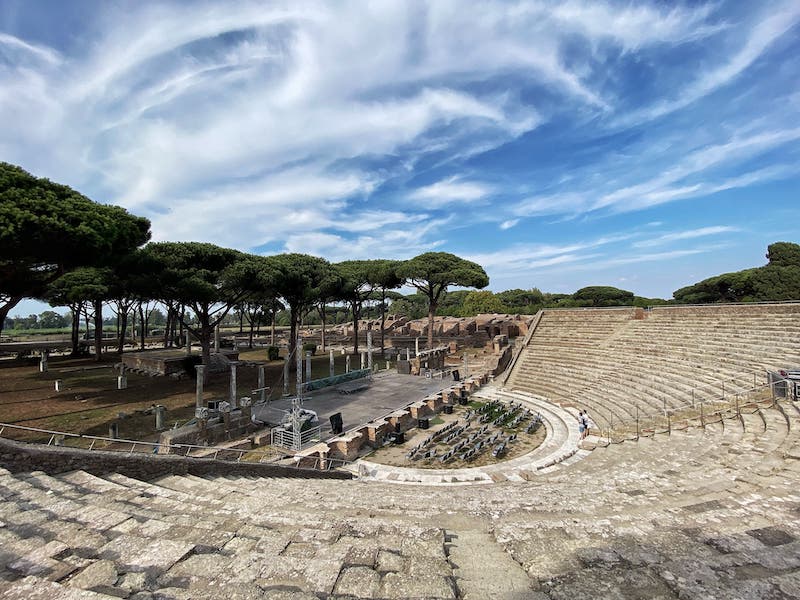
Main sights in Ostia Antica
Like many Roman cities, Ostia Antica had a grid layout. The main street was the “Decumanus maximum” – walking along it, you will find ruins to your left and to your right. Here are some ruins that are worth noting.
Ostia Antica theater
Probably the most impressive building in Ostia Antica, it’s one of the oldest brick theaters in the world, and you can actually access it from the front and from the back too – so you can see the main stage as well as the spectators seats. It’s interesting to note that the theater is still used for concerts today.
Located in front of the theater, this was the commercial heart of the city, with more than 60 offices representing the various guilds, shops, warehouses. On its sidewalk, you will also be able to spot some gorgeous mosaics that typically represent what the shop sold or offered.

The Thermopilum
Located on one of the side streets from the decumanus, this was an ancient café or restaurant – a place where people would not only eat but also socialize.
The baths of Neptune
This massive complex was actually funded and subsidized by the government. It was not only a place to keep personal hygiene, but very much a place to socialize. Marble steps led to the pools, where people washed using olive oil rather than soap. There is a viewpoint overlooking the baths of Neptune where you can spot a mosaic of Neptune riding four horses through the waves.
Farther down in the area of Via della Foce, by the Porta Marina, you will find a beautiful example of a Roman Domus – the house of a rich family.
House of Diana
A fantastic example of an insulae – a multi-storied complex that provided housing to families of the middle class. It’s close to the Thermopolium.
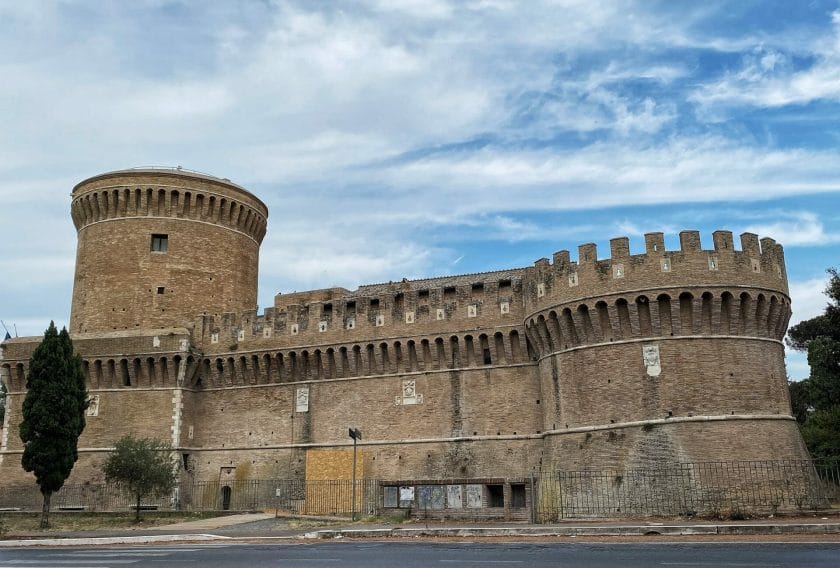
The medieval Ostia Antica Hamlet
As you exit the site, you will find yourself right in front of the Castello di Giulio II – Ostia castle. It’s quite an impressive site, that marks the main landmark in the tiny Ostia Antica Hamlet . It was built in 1483 by the cardinal Giuliano della Rovere (future Pope Julius II) and it is a great example of Renaissance military architecture, with cannon-proof rooms, three towers and a higher one meant to protect the main gate, and a wide ditch.
The Castle and the Hamlet were abandoned after the siege of the Duke of Alba of 1556. In 1557 a flood finally deviated the course of the Tiber River and malarious swamps increased in the area, making it unsafe to live there. In subsequent centuries, the castle was used as a prison: prisoners kept there were used for forced labor, including the excavations of Ostia Antica.
There is also a church and other low-rise buildings in the hamlet – it is honestly very small and will take you no more than 15 minutes to visit (unless you go inside the castle); but it’s a nice place to conclude your day trip to Ostia Antica from Rome.
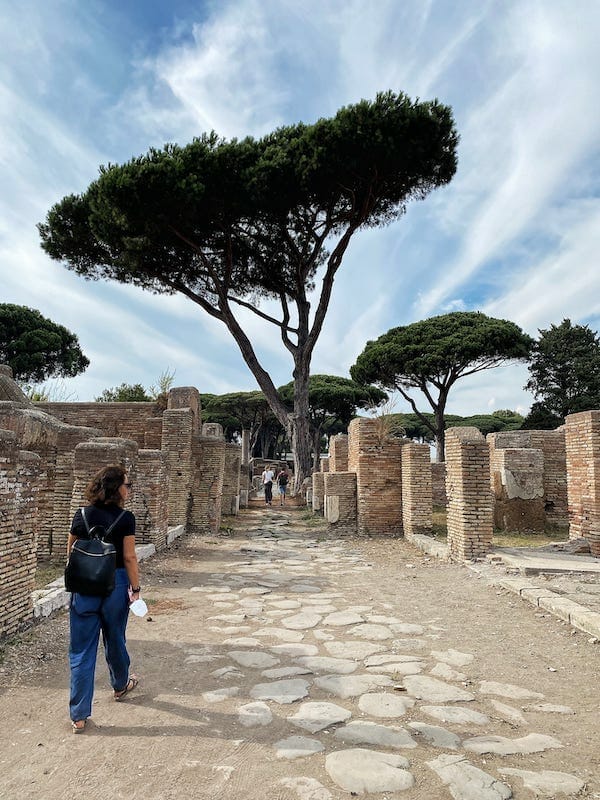
Practical Information To Visit Ostia Antica, Rome
Now that you know what’s so special about Ostia Antica, let’s see what you need to know to plan your day trip to Ostia Antica from Rome.
Do you need a guide to visit Ostia Antica?
Some travelers will tell you that you can definitely visit Ostia Antica independently and you don’t need a guide. I honestly disagree with that. My sister and I have visited recently and we truly regretted not having a guide, as it would have made our experience a million times better.
The site is massive – there is a lot to see, and while you won’t get lost, it’s definitely better to have someone to take you around to all the main points of interest so that you don’t have to constantly look at the map.
Furthermore, such an important site in Roman history deserves a more in-depth visit than what you’ll get by simply reading the signs placed by the main landmarks. Also, keep in mind that audioguides are currently not available at the ticket office, and there are no guides ready to take you around the site – so you will really have to arrange one in advance.
You can book your guided tour of Ostia Antica with an archeologist here . If you’d rather have a smaller group, you may want to check this other tour here .
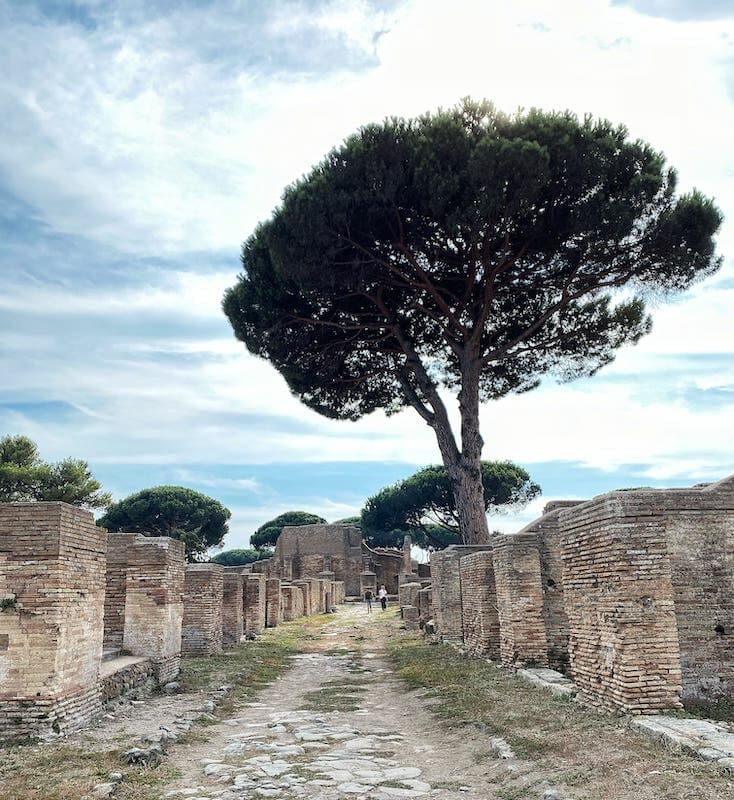
The best tours of Ostia Antica
As I have hinted before, you will get much more out of your visit if you hire a guide or join a guided tour. There are all sorts of tours that you can book online. Some start directly at the site – which is super easy to reach from Rome (more about that in a bit); others include transportation from Rome (usually by train anyways). Here is a selection of the best tours you can book online:
ANCIENT OSTIA GUIDED WALKING TOUR – This tour departs directly from the site and is for a maximum of 10 participants. The guide is a local archeologist with in depth knowledge of the site. Ostia Antica tickets are included in the price. You can book it here .
OSTIA ANTICA HALF DAY TOUR FROM ROME BY TRAIN – This is the most hassle-free tour on sale The meeting point is in Rome Piramide, from where a guide will safely lead you to the train and then around the site. It’s a small group tour of no more than 12 participants and it includes roundtrip train tickets and the admission fee. You can book it here .
GUIDED TOUR OF ANCIENT OSTIA WITH A LOCAL ARCHEOLOGIST – The most expensive option, while transportation is not included, tickets are and this is a semi-private tour – so a great option if you want to be in an even smaller group. You can book it here .
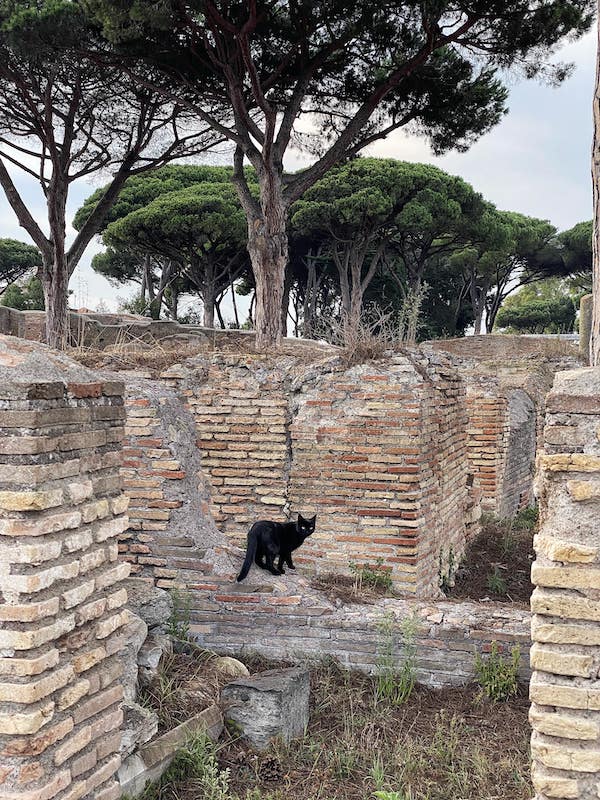
How to get to Ostia Antica from Rome
Getting to Ostia Antica from Rome is very easy, and you have several options.
Take the train to Ostia Antica from Rome
The easiest way to get to Ostia Antica from Rome is by commuter train. Regular trains depart from Roma Ostiense station and will take you to the site in about 30 minutes.
To get to Roma Ostiense you’ll have to take Metro line B (from Termini or Colosseo) and get off at Piramide. From there, it’s a 5 minutes walk to get to Roma Ostiense train station.
Since the train is actually part of Rome’s public transport network, you can use the same ticket you’d use on any metro or bus in Rome – and it costs just €1.50 (kids under 10 years of age go free). If you have a Roma Pass, this should normally include public transport too.
The train will leave you at Ostia Antica train station, from where you need to climb up a flight of stairs and cross a bridge to get to the archeological site. The bridge is not accessible to those with mobility issues or on wheelchair – if that’s your case, you will have to follow the longer route that goes to the hamlet and from there access the site via the main gate.
With such an efficient public transportation system, you should not really bother driving all the way to Ostia Antica – it means having to battle the terrible traffic in Rome! If that’s what you want to do, anyways, you’ll have to follow SP 8 to get all the way there. It will take you approximately 45 minutes. Parking is available on site.
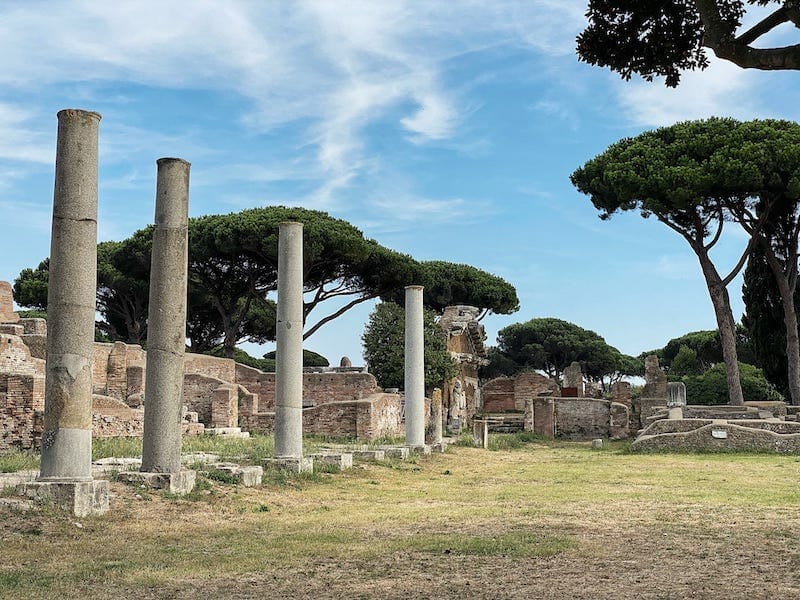
Ostia Antica tickets
Ostia Antica tickets are priced as follows:
- ADULTS: € 18
- REDUCED: € 2 (EU citizens between 18 and 25)
Free Ostia Antica tickets are available, among others, for the following categories:
- Anybody younger than 18
- Disabled visitors and their carer
- EU licensed guides, as long as they are leading a group
- EU interpreters, as long as they are accompanying a guide and a group, and provided they have a valid license.
Ostia Antica tickets can be purchased directly at the ticket counter, or in advance on the official site, here . Keep in mind that the official site doesn’t allow modifications to your ticket reservations, or cancellations.
Audio-guides are no longer available. At the time of writing, the Museo Ostiense – which is a great addition to a visit to the site – is temporarily closed.
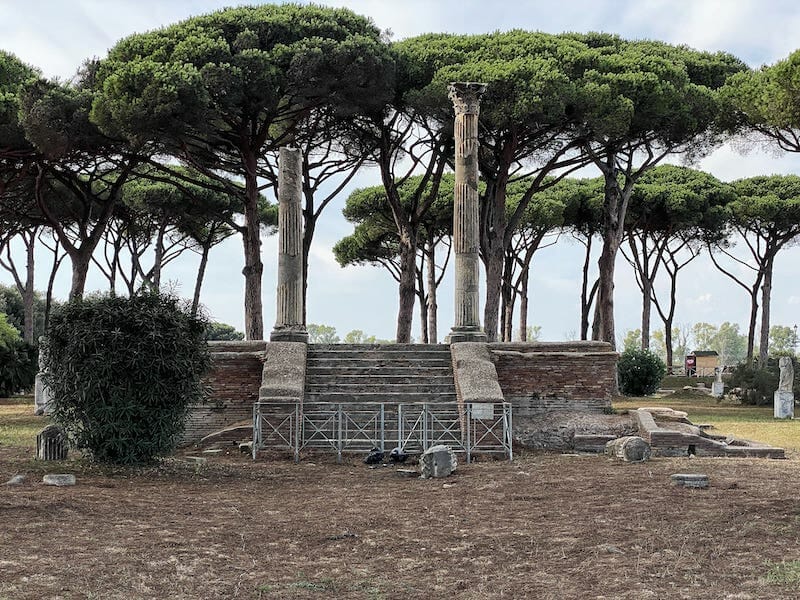
Opening hours
Ostia Antica Archeological Site is open for visits Tuesday to Sunday, and observes the following opening hours:
- October 25th to February 28th or 29th from 8:30 am to 4:30 pm; last admission at 3:30 pm;
- March 1st to March 31st from 8:30 am to 5:15 pm; last admission at 4:15 pm;
- April 1st to September 30th from 8:30 am to 7:00 pm; last admission at 6:00 pm;
- October 1st to October 24th from 8:30 am to 6:30 pm; last admission at 5:30 pm.
The ticket counter closes one hour before the site.
The site is closed on Monday, January 1st, May 1st and December 25th.
Toilets are located by the ticket counter. That’s where you will also find automatic distributors of water, drinks and other snacks.
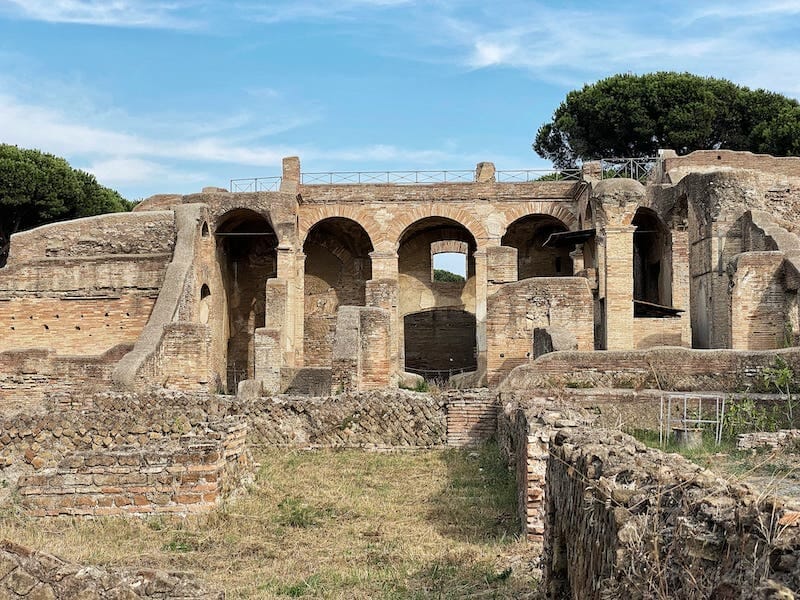
Other useful information
Most of the site is accessible to people with limited mobility or on wheelchair; there are also services for the visually and hearing impaired.
What to wear and what to pack to visit Ostia Antica
Make sure to wear comfortable clothes and good walking shoes when visiting Ostia Antica. Walking sandals are ok, but flip flops won’t do as there is quite a bit of walking to do and the site is not paved.
Other than that, these are a few useful items you may want to bring:
- Water bottle – there is a bottled water distributor by the ticket counter, as well as a fountain. Water in Rome is safe to drink so you may want to just refill and avoid using plastic.
- Mosquito repellent – if you are visiting Rome in August or in the summer months, there may be quite a few mosquitoes around.
- Sunhat and sunglasses – again, if you are visiting in the summer these are a must!
- Sunscreen .
Further Readings
Planning a trip to Rome? Make sure to read these other posts:
- Where Is Rome?
- Is Rome Worth Visiting?
- The Most Famous Landmarks In Rome
- A Guide To Rome Mithraeum Temples
Pin It For Later!

Claudia Tavani
Claudia Tavani was born and raised in Italy, but she also lived in New York, Denver, and London. She's a professional travel blogger and certified travel designer who loves planning trips, sharing travel hacks, and packing lists so that you don't have to. Owner of My Adventures Across The World, solo traveler, cat mom to Minnie. Claudia has been featured by the Lonely Planet and the Huffington Post. She has visited more than 80 countries.
2 thoughts on “How To Visit Ostia Antica, Rome”
I was here (again) in early May Site is so big is impossible to take it all in at one visit I have a pocket guide book which cost me 10 euros which am reading again back in England title is Ancient Ostia Past and Present Strongly recommend It costs 10 Euros
Or else, a guided tour!
Leave a Comment
This site uses Akismet to reduce spam. Learn how your comment data is processed .
Privacy Overview
- TAXI FARES CALCULATOR
- BOOK PRIVATE TOUR
- How to Choose a Hotel in Rome
- Tickets to Vatican museums
- Rome Three Day Itinerary
- 2025 Pilgrims of Hope Jubilee
- Rainy Days in Rome
- Buying a Sim Card in Italy
- Renting a Car in Rome
- Apps for Tourists
- Souvenirs from Rome
- Free Things to Do
- Unusual Things to do
- Public Transport
- Hotels with Best Views
- Hotels near Termini
- Hotels near the Colloseum
- 3 Star Hotels
- 4 Star Hotels
- 5 Star Hotels
- Apartments For Rent
- Best Hostels
- Borghese Gallery
- Roman Forum
- Trevi Fountain
- Spanish Steps
- Castel Sant’Angelo
- Navona Square
- Ancient Sites and Ruins
- Caravaggio’s Paintings
- Galleries and Museums
- Parks and Gardens
- Squares and Fountains
- St Peter’s Basilica
- Sistine Chapel
- Vatican Museums
- Raphael’s Rooms
- Michelangelo’s Pieta
- St Peters Dome
- St Peter’s Square
- Vatican Gardens
- Vatican Military
- Swiss Guard
- To Ostia Antica
- Beaches near Rome
- To Alberobello
- Fiumicino Airport
- Ciampino Airport
- Termini Railway Station
- To Florence
- Famous Roman Dishes
- Best Pizza Places
- Best Pasta Places
- Local Italian Food
- Best Gelato Places
- Best Rooftop Bars
- Campo Marzio
- Jewish Ghetto Quarters
- Quartiere Coppedè
- Sant’Eustachio
- Marcus Aurelius
- Gaius Julius Caesar
- Octavian Augustus
Ostia Antica Ruins: Rome’s Ancient Harbor
Written by: Kate Zusmann
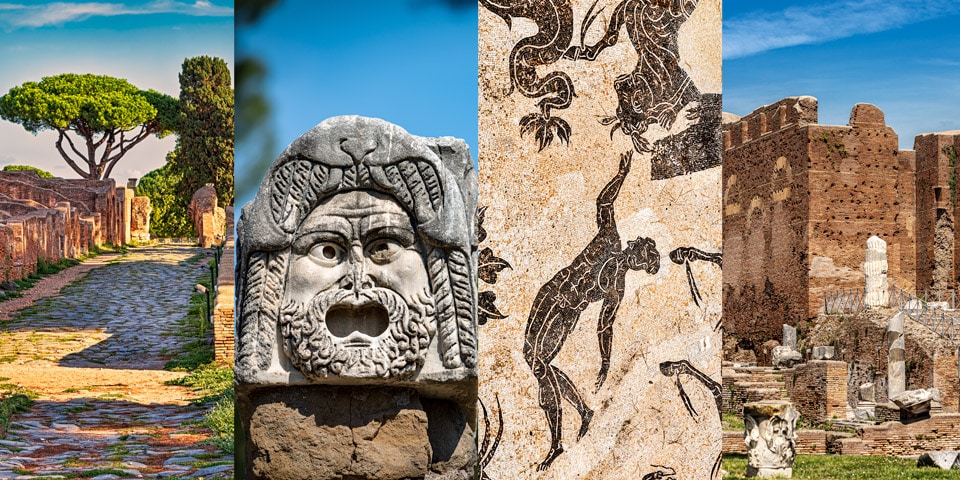
Ostia Antica is a large archeological site near Rome on the Tiber River . It had the status of Rome’s harbor or port city during ancient times. However, after the Roman Empire fell, the city became abandoned and remained untouched and preserved for centuries. Today, the Roman ruins of Ostia Antica, which served as the old city’s seaport, attract visitors worldwide.
Things to Know before Visiting Ostia Antica
Is ostia antica worth visiting, where better to go for a day trip from rome to ostia antica or pompeii, how long does it take to see ostia antica, why is ostia antica so well preserved, when was ostia antica built, why was ostia antica abandoned, interesting facts about ostia antica.
Below are 11 interesting and unusual historical facts about Ancient Ostia. Memorize a few and surprise your friends while visiting the archaeological site.
- Ostia Antica, Rome’s ancient harbor city, was founded around the 4th century BC and served as a vital commercial and military hub, connecting Rome to the Mediterranean world through the Tiber River.
- At its peak, Ostia Antica was home to approximately 50,000 people , making it one of the largest and most prosperous cities in the Roman Empire.
- The ancient city boasts remarkably well-preserved ruins, including the remains of the impressive amphitheater, which could accommodate up to 3,500 spectators for various events, such as gladiator games and theatrical performances.
- Ostia Antica features an intricate network of streets, with over 60 miles (100 km) of roads, demonstrating the advanced urban planning and engineering capabilities of ancient Rome.
- The city was adorned with numerous public baths, or “thermae,” which were not only centers for hygiene but also for socialization and relaxation. The Baths of Neptune, with their stunning mosaic floors, are a prime example of Ostia’s opulent bathing culture.
- Ostia Antica was home to the Synagogue of Ostia, built around the 1st century AD, which is the oldest known synagogue in Europe and an important testament to the presence of a thriving Jewish community in ancient Rome.
- The House of Cupid and Psyche in Ostia Antica features an exquisite second-century AD mosaic depicting the famous love story from Roman mythology, showcasing the city’s rich artistic heritage.
- The city’s main shopping area, the Piazzale delle Corporazioni, was a bustling marketplace where merchants from all corners of the empire traded goods, such as spices, textiles, and exotic animals.
- The fire of Rome in 64 AD, during Nero’s reign, led to Ostia Antica’s rapid expansion, as the harbor became a crucial supply point for rebuilding the devastated city.
- Ostia Antica was gradually abandoned after the fall of the Roman Empire, with the changing course of the Tiber River and repeated invasions making it less viable as a harbor. Today, the archaeological site offers a fascinating glimpse into the daily life of an ancient Roman city, attracting history enthusiasts from around the world.
- Modern Ostia is home to the closest beach to Rome, Lido di Ostia. See the list of the closest beaches to Rome where locals go.
History of Ostia Antica
Ostia was founded around 620 B.C.
In 400 B.C., Rome conquered the city and made it a naval base. By 150 A.D., Ostia served as a commercial Rome’s ancient Port. However, with the fall of Rome, the Port was abandoned, and the harbor silted up over time.
A small museum in Ostia offers statuaries of tangled wrestlers kissing cupids, works are from the 2nd to 3rd centuries of and gods most of the art and m A.D. Most of the masterpieces are inspired by Greek originals, and many of them are from different religions. Since Ostia was a port, it accommodated people from all over the world.
Nowadays, you can walk on a vast territory full of ruins and unique buildings that went through centuries. The main street, Decumanus Maximus , was once full of carrucas , the four-wheeled carts that ferried merchandise and luggage between Rome and Ostia. Moreover, two-wheeled cisia was used as public transportation for commuters.
One of the main sites to see is Ostia’s amphitheater.
Founded in 12 B.C., it is a magnificent and well-preserved building, which fascinates with its size and beauty. Behind the theater is the Forum of Corporations, which served as the building with the offices of sixty-four maritime companies. You will still find mosaic names, pictures on the ground in front of each office, and a covered corridor.
In the age of Emperor Claudius , the place was raised by a second level to create the seats of the collegia , which is the association of trades for business making. The Temple of Ceres is in the middle of the Forum. Also, there are the Baths of Neptune with mosaics of the sea god. Additionally, the site is right near the modern café, where you can book a tour.
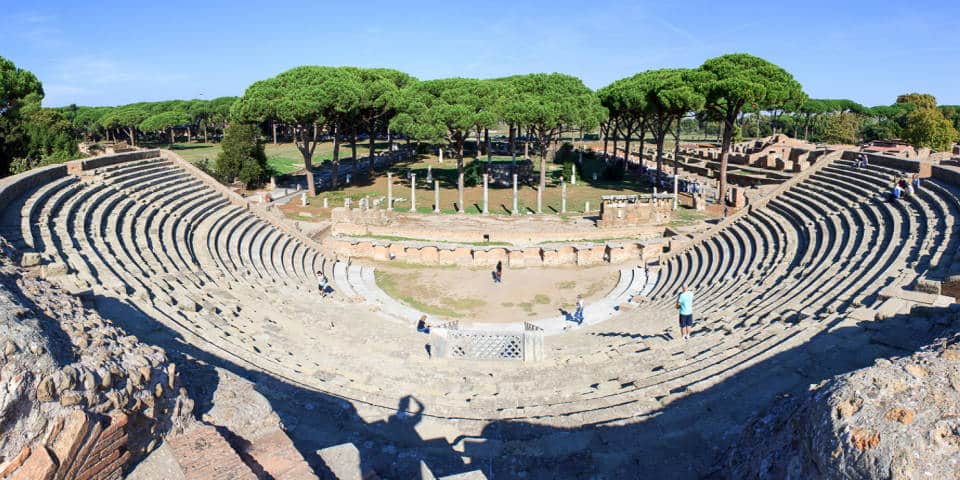
Don’t forget about the high podium of the Collegiate Temple. Interestingly, it was a social club for men of the poorer classes, where they afforded themselves a kind of a banquet while the rich could afford it daily. The dinners began at 3 pm and lasted until the sun’s rise.
Women weren’t invited to the banquets.
Moreover, enslaved people were doing washings in the small terracotta tubs on the brick counters. Their heads were shaved as a distinguishing sign. The laundry is located near the public baths.
Ostia reached 50,000 inhabitants during its development, but around the third century A.D., a deep crisis decreased trade and commerce. Consequently, part of the inhabitants left the city. After the fifth century A.D., there economic recovery of the city led to the move of all commercial and administrative activities to the Port of Trajan. In addition, the Port was highly protected from storms and enemy incursions.
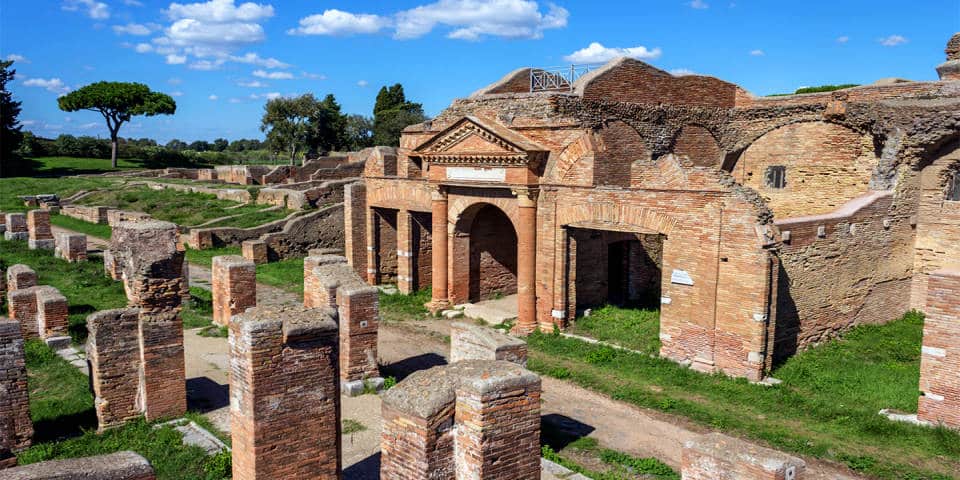
At the center of the square, the temple was built over a podium in the age of Emperor Domitian , among gardens and open spaces decorated with statues.
The three Masks turned to the stage of the Theater.
How to Get to Ostia Antica from Rome
Public transport is the most economical way to get to the archaeological site of Ostia Antica from Rome. Since Ostia is part of the metropolis, a 1.5-euro city ticket is enough for the trip, which is valid for 100 minutes.
First, you must get to Pyramide metro station (blue line B). Then get to Porta San Paolo and take the first train on the Roma-Lido di Ostia line, stopping at Ostia Antica. Trains leave every 20 minutes, and travel time is about 30 minutes.
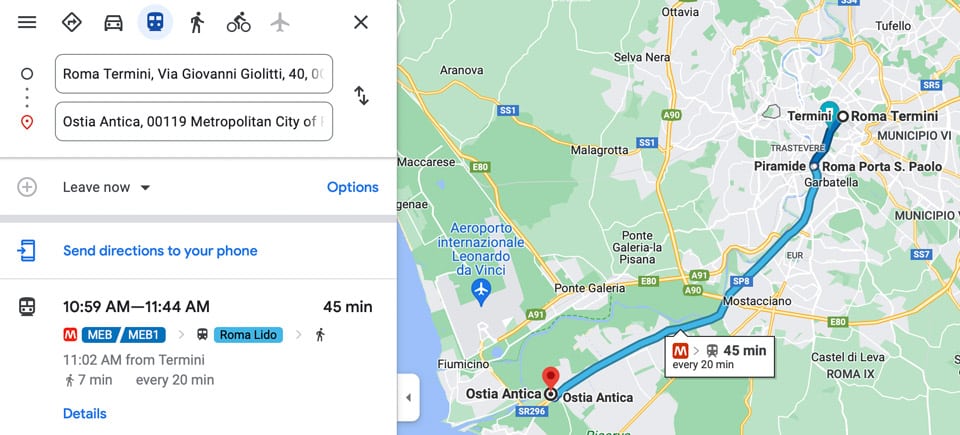
See detailed instructions with photos on how to get to Ostia from Rome by train.
Private transfer from Rome to Ostia Antica
A private transfer from Rome is the most convenient way to get to Ostia. You will be picked up right at the hotel and taken directly to the entrance to the archaeological complex. A round trip will cost 120 euros for a group of up to 4 people. The trip in a premium-class car with air conditioning will take about 35-40 minutes. To book a trip, I recommend contacting the most punctual transfer service in Rome, Sergio & Partners .
Ostia Antica vs. Pompei – What is Better to Visit from Rome?
Ostia Antica and Pompeii are remarkable archaeological sites offering unique insights into ancient Roman life. Choosing which one to visit from Rome depends on your interests, time constraints, and travel preferences.
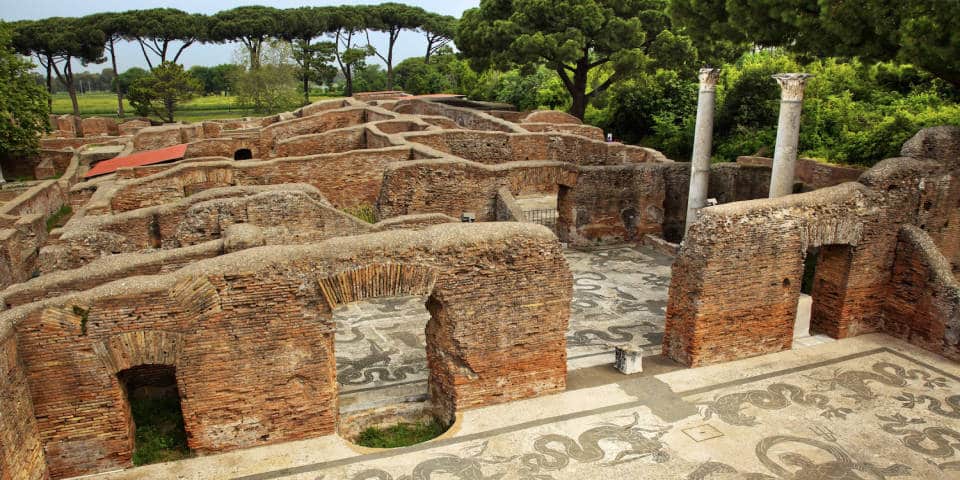
Ostia Antica, located just 15 miles (25 km) southwest of Rome, is more easily accessible and requires less travel time than Pompeii. A visit to Ostia Antica can be comfortably done as a half-day trip from Rome, making it an excellent choice for those with limited time or who prefer a shorter journey. As Rome’s ancient harbor city, Ostia Antica boasts well-preserved ruins, including an amphitheater, baths, and intricate mosaics. The site is generally less crowded than Pompeii, allowing for a more relaxed and intimate exploration of the ruins.
Pompeii, on the other hand, is situated about 150 miles (240 km) southeast of Rome, near Naples. A visit to Pompeii from Rome typically involves a full-day trip, as the journey by train or car takes around 3 to 4 hours each way. Pompeii is renowned for its dramatic history, having been buried under volcanic ash during the eruption of Mount Vesuvius in 79 AD. The site offers a haunting yet fascinating glimpse into the lives of the people who lived there, with many buildings, frescoes, and artifacts preserved in remarkable detail. Pompeii is larger and more famous than Ostia Antica, often attracting larger crowds of tourists.
In summary, if you have limited time or prefer a more relaxed and convenient experience, Ostia Antica is an excellent choice for a visit from Rome. However, if you are intrigued by Pompeii’s dramatic history and don’t mind dedicating a full day to travel and exploration, Pompeii offers a unique and unforgettable experience. Both sites provide a fascinating look into ancient Roman life, and the choice ultimately depends on your personal preferences and travel itinerary.
Read how to get to Naples from Rome and where to travel from Rome .
Nearby Attractions
Author: Kate Zusmann
I have lived in the Eternal City for the past 12 years. They say every angle of Rome has its history, and I'm here to tell you about the most intriguing historical facts and city legends. :)
Dive Deeper into Rome's Stories
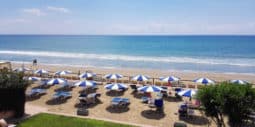
21667 views
Best Beaches near Rome
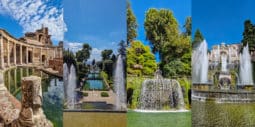
One-day trip to Tivoli from Rome

13648 views
Trip from Rome to Alberobello

Explore Rome

What material is the Colosseum made of?

What is the Area of Vatican City?

11905 views
Emperor Claudius

Where is the Vatican Church?

18377 views
Altar of The Fatherland – The Victor Emmanuel II Monument
Rome.us © 2024. Created with love by Roman experts and guides.

Ostrich Trails
Because it is a walking bird and walking is what we do.
Ostia Antica Walking Tour
Home » Europe » Italy » Ostia Antica Walking Tour
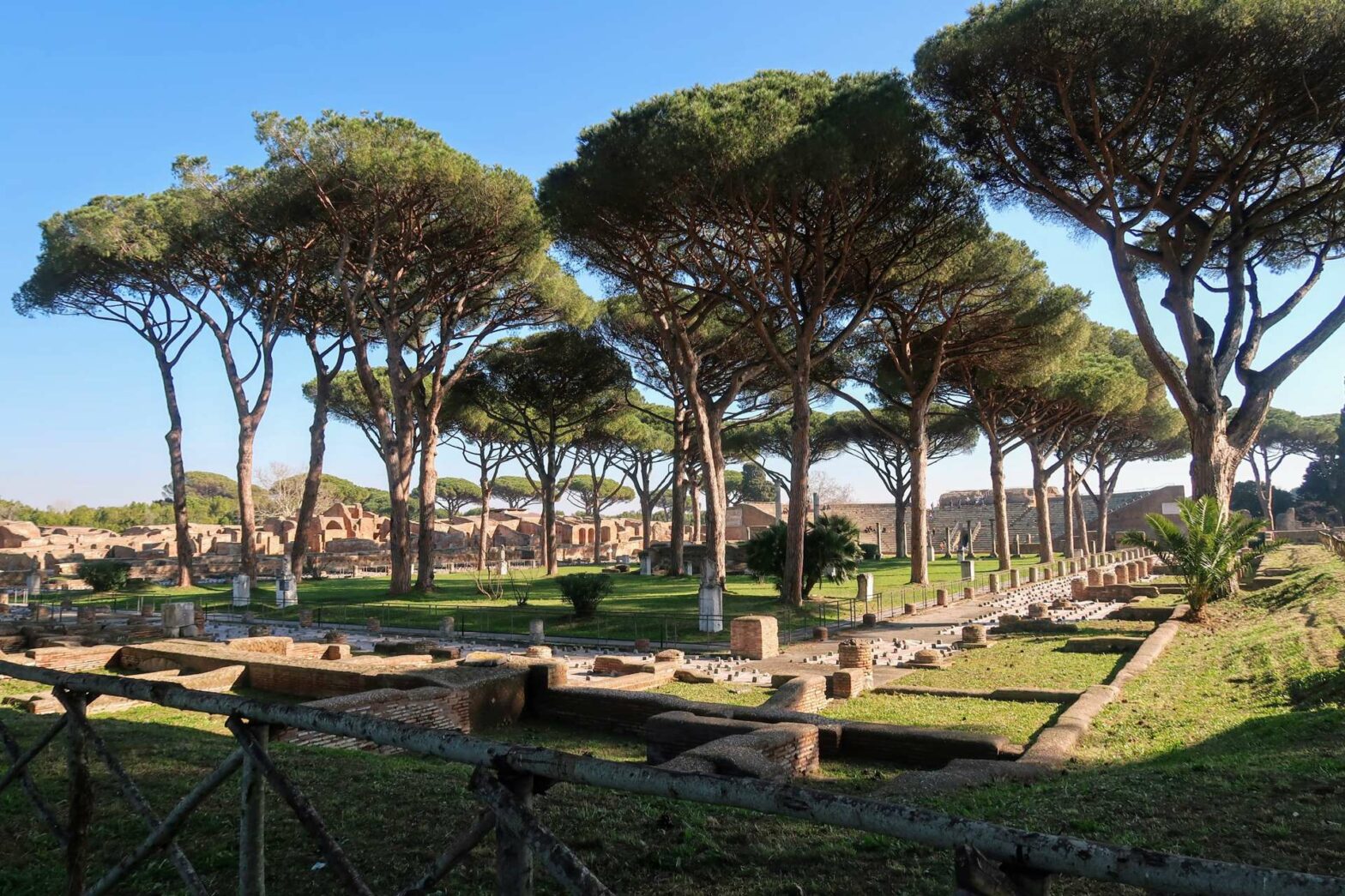
By Vicky · Published Feb. 23rd, 2024
When you buy through links highlighted with an asterisk (*) on this site, we may earn a small affiliate commission at no cost to you.
This self-guided walking tour of Ostia Antica brings you to all the top sights in the ruins of this ancient harbour not far from Rome. It’s a great half-day trip; the ruins are rather spectacular and there are far fewer tourists/cars/pollution than in central Rome.
Page Contents:
How to get to Ostia Antica from Rome
The train is the best way to get to Ostia Antica from Rome. The train leaves from Roma Porta S. Paolo Train Station , opposite the Pyramid of Caius Cestius and the Protestant Cemetery. It’s also called the Rome-Lido Railway. To get to the train station you can either take the Metro (B Line) or any of several buses.
The train from Rome to Ostia Antica leaves every 22 minutes starting around 5:30 am and ending around 11 pm. The journey itself takes 26 minutes. If you’re using Google to navigate, it occasionally adds an extra train that doesn’t exist in between the trains spaced at 22 minutes. These ‘extra trains’ are a mistake.
The stop you want to get off at is simply called Ostia Antica. From here, clear signs direct you to the archaeological site and it’s a 10-minute walk. First, you have to walk under the railway to cross to the other side, then head across a bridge over a highway. Heading straight onward along a quiet street, you’ll soon reach the car park, ticket office, and the entrance to Ostia Antica.
How much does a train ticket from Rome to Ostia Antica cost?
The cost of the train from Rome to Ostia Antica is €1.50. It’s within Rome metropolitan area, where all journeys are €1.50 if completed within 100 minutes. If you take the bus to the train station, then the entire journey is still only €1.50. Just tap-and-go with your debit card both on the bus and at the gates to get into the train station. The return journey from Ostia Antica to Rome is then also €1.50.
Ostia Antica Walking Tour Map
Get the route by downloading the .gpx or .kml file below. For navigation with Maps.me on your mobile phone, simply download the .kml file and open to add it to the Maps.me bookmarks.
Information for a Visit to Ostia Antica
Ostia antica tickets.
Tickets to Ostia Antica cost €18/2 for adults/reductions (18-25 EU citizens) and are free for children. Audioguides are an extra €5/7 for a short/long version. It’s free (but crowded) on the first Sunday of the month. If you aren’t on a guided tour, audioguides are potentially worth it as otherwise all the ruined walls may look quite similar. However, there are enough information signs around the archaeological area that audioguides are not essential.
Tickets to Ostia Antica actually include all the sites managed by the Archaeological Park of Ostia Antica and are valid for 8 days from the first entry. These other sites include:
- Julius II Castle (5 minute’s walk from Ostia Antica entrance)
- Museum of the Roman Ships from Fiumicino (near Fiumicino airport)
- Imperial Harbours of Claudius and Trajan
- Necropolis of Portus in the Isola Sacra
If you haven’t got a car, the Imperial Harbour and Necropolis of Portus are difficult to reach. However, Julius II Castle is very close to the main Ostia Antica archaeological park, so it’s worth taking at least a short look. The Museum of Roman Ships from Fiumicino is very close to the airport of the same name. Since the tickets are valid for 8 days from first use, if you’re leaving a few days later from this airport you can visit the museum while waiting for your flight. From the airport, it’s a 20-minute walk or there’s a free shuttle bus every 30 minutes to the museum.
Ostia Antica Opening Hours
The historical site of Ostia Antica is open from Tuesday to Sunday. It opens at 8:30 am all year round and closes between 4:30 pm and 7 pm depending on the season. Check the Official Website for more information.
What to Wear to Ostia Antica
The most important thing to wear to Ostia Antica is comfortable shoes for walking. It’s a very large site, and the ground is mostly cobbles, ancient Roman roads, or dirt. Trainers (sneakers) are highly recommended. As for clothes, you are allowed to wear whatever you like (unlike some of the churches in Rome where you have to cover shoulders and knees). There’s not much shade, so it’s best to cover your shoulders anyway to avoid sunburn. Sunglasses and a sunhat are also recommended, and don’t forget the sunscreen either!
More Tips for Visiting Ostia Antica
- Picnics are not allowed, but there’s a good cafe inside, Café degli Scavi, which has reasonable prices and decent food. Take a water bottle and snacks to keep you going when walking around.
- Allow at least 3 hours, and up to 5 hours if you want to see everything at Ostia Antica.
- In winter, many of the floor mosaics are covered up so you can’t see them. However, a few are left uncovered.
- There are toilets at the entrance and at the cafe.
- Save the museum either for the hottest part of the day (mid-afternoon) or go there for a relatively cool break halfway around.
Top Things to See at Ostia Antica
On this self-guided walking tour of Ostia Antica, you’ll visit all the best things to see in this ancient harbour. These include:
- Decumanus Maximus
- Baths of Neptune Viewpoint
- Mithraeum of the Serpents
- Mill & Bakery
- Thermopolium
- Ancient Toilet
- Terme del Foro
- Fishmongers’ Shops
- Terme dei Sette Sapienti
- House of Cupid & Psyche
- Jars in the ground
- Ostia Antica Museum
If you prefer, there’s a great guided tour of Ostia Antica * where you’ll be accompanied from Rome to the site and shown around by a knowledgeable guide.
Ostia Antica Self-Guided Walking Tour Route
This walking tour starts from the ticket office at Ostia Antica.
Directions: Head into the main archaeological site.
1. Decumanus Maximus
You’ll now be on Decumanus Maximus, the main street through Ostia Antica. The same name was given to one of the main streets in most Roman towns. Walking along this street, the first thing you’ll see is the necropolis, or city of the dead, on your left. There are many tombs here, and you can still see fine details on some of them. This cemetery is outside the city walls since the dead were not allowed to be buried inside.
You’ll soon come to the remains of an old gate, the Porta Romana, within what’s left of the walls. You’ll see the base of a marble arch support and a few other bits of marble cladding. Like elsewhere in Ostia Antica, there’s also an information board (in Italian and German) to explain more about what you’re looking at.
Most of the other main things to see in Ostia Antica can be reached directly from the Decumanus Maximus, and this walking tour follows it with a few deviations until the far end of the site before returning via the museum.
Directions: Head through the gate and about 250 metres later you’ll see a viewpoint up some steps on your right.
2. Baths of Neptune Viewpoint
The Baths of Neptune Viewpoint is the first of several on this walking tour of Ostia Antica. From the top of the steps, you can first see the large extent of the ancient ruins here. From this vantage point you can also see the many fine mosaics within the Baths complex. The grassy open area to your left was also part of the baths. It was a space where the bathers could simply sit, relax, and chat to each other, as well as being a sort of changing room.
Directions: Continuing along the main street you’ll soon see the obvious theatre building on your right.
The Theatre is one of the most impressive and best-preserved sections of Ostia Antica. It’s even still used today for performances in summer! If it looks a little small, that’s because originally it was twice as tall, but the top rows of seats have been lost over time. Don’t miss the three carved funny faces at the bottom on your left as you look at the stage.
You’ll also see some remains of a temple in what’s now a grassy area with trees. This temple was probably either dedicated to Ceres, the goddess of grain, or Dionysus, the god of theatre. The square around the temple is known as the Piazza of the Corporations. It was home to the most important guilds in the city, and the floor mosaics give you a clue as to what these were.
Directions: Take a loop around the piazza before returning to the Decumanus Maximus. About 150 metres keep an eye out for the Mithraeum of the Serpents, or Mitreo dei Serpenti, on your left.
4. Mithraeum of the Serpents
The Mithraeum of the Serpents is dedicated to the god Mithras. He was a god imported from the East, perhaps from Persia, and a cult worshipping him developed in the Roman Empire. Many temples to Mithras are underground, or hidden. Today you can still see a wall painting of a snake and some benches. The snake was a common symbol as they evoked the fertility of the earth, and the benches were used for lying on during cult banquets.
Directions: Take the next street to your right and just past the first junction you’ll see the mill on your left.
5. Mill & Bakery
The Mill & Bakery is where grain was ground into flour and turned into bread. Today you can still see several millstones made of dark volcanic rock, almost as if the bakery was functioning yesterday. You’ll also find some of the other tools used in the bread-making process such as mixers and a large oven at the back. Conveniently, the building opposite was the main grain storage depot in town.
Directions: Retrace your steps a few meters and go down the side street, Via di Diana.
6. Thermopolium (Ancient Pub)
The Thermopolium, or Ancient Pub, is one of the most fun places to visit in Ostia Antica and definitely not to be missed. You can still see the bar area, which looks very much like a bar today, and you can imagine the bartenders storing their drinks on the shelves and serving the people coming in. There’s also a wall painting of things on the menu and something like a Biergarten out the back.
Opposite the pub, you’ll see some steps leading up to a great viewpoint. Head up for views of the Forum and its surroundings.
Directions: Return to the main street and the large open square.
The Forum is the central square of Ostia Antica, similar to several squares, or piazzas, in Rome today. At one end you have the obvious large building, the Capitolium. This is a monumental temple dedicated to Jupiter, Juno, and Minerva, the three most important Roman Gods. At the other end of the square is a less well-preserved temple dedicated to Roma and Augustus, the personification of Rome and the great Caesar.
Directions: Head to the opposite side of the forum from the big Caitolium and take a left up a couple of steps just before the arch. Walk a short distance and you’ll see the next stop on your left.
8. Ancient Toilet
This ancient toilet has remained fairly unchanged since it was used in Roman times. There wasn’t much privacy back then, people just sat next to each other on a bench with holes in it to do their business. A flow of running water then washed everything away from below, very hygienic!
Directions: Return back to the Forum and take the next set of steps to the left, up into an ancient baths complex.
9. Terme del Foro
The Terme del Foro is a bath complex close to the Forum. There are actually many bathing areas in Ostia Antica, and this is just one of them. There were baths of different temperatures, including very cold and quite warm, as well as saunas and areas for changing and chatting and an area for sunbathing. Look out for the hollow bricks surrounding the walls that brought a steady stream of hot air into some of the rooms.
Directions: Leave the Forum and continue along Decumanus Maximus. You’ll soon cross the city walls and come to a splitting of ways. Take the left and you’ll see the fish shops almost immediately on your left.
10. Fishmongers’ Shops
The Fishmongers’ Shops still have sea and fish-related mosaics on the floor, tables for cutting the fish and sinks to wash them in. It’s really like you can imagine a fishmonger working here and selling his fish to the people walking past on the street.
Directions: Continue onwards and take the first street on the right. Just over 100 metres after the junction, turn right into the building complex to find the next baths.
11. Terme dei Sette Sapienti
You’ll pass a few wall paintings, including one of a woman with a lobster and fish near the entrance to the Terme dei Sette Sapienti, or Baths of the Seven Wise Men. A short distance further there’s a great mosaic on the floor showing lots of wild animals.
Directions: Continue through the complex and out to the street on the other side. Directly opposite, don’t miss the mosaic on the floor of the Hall of the Grain Measurers (Aula dei Misuratori del Grano). Walk right, then left after the big trees and then take the first right. The next stop is on your left.
12. House of Cupid & Psyche
The House of Cupid & Psyche was a luxurious dwelling and you can still see intricate floor mosaics, columns, marble and the statue of Cupid & Psyche after which the house is named. This statue was found on a pedestal in a room of this house when it was excavated. What you see here is now a plaster cast in the same place where the original (which is now in the museum) was discovered.
Directions: Head onwards, then make a loop through the area where some artefacts are stored, and towards the museum. Just before you arrive, before the steps up to the building, is the next stop.
13. Jars in the ground
Here you can see many large jars half-buried in the ground. These were used to store liquids such as oil and wine, and they were already partly buried when in use to make sure they didn’t fall over. Some of the jars indicate how much they contain, measured in terms of amphorae , roughly 26 litres. In several of the jars, molds used perhaps to make cakes were found, covered in patterns and carvings of animals and people.
Directions: Head into the museum.
14. Ostia Antica Museum
The Ostia Antica Museum houses many finds from the archaeological park. They’re mainly statues, marble inscriptions, and mosaics. It’s quite small so only takes about 20 minutes to walk around, but it’s definitely worth taking a look.
Directions: From here, leave the museum to the left and take a left again to reach a small road. Walk along here back to the entrance. The road is slightly raised so you get a nice overview of the excavations and can see a fun mosaic in the Terme dei Cisiarii. It’s also a very shady route.
Castello di Giulio II
Key Information: Opening hours of the castle vary throughout the year, and it opens between 10:30am and 1:30pm. Check the full opening hours here . If you just visit the castle, a ticket is €6/2, but it’s free with your ticket to Ostia Antica.
If you still have time, the Castello di Giulio II, or Julius II Castle, is 5 minutes walk from the entrance to Ostia Antica and included in your ticket. Even if you don’t go inside, it’s nice to wander into the medieval hamlet in front of the castle. You’ll find many old buildings here, including the Cattedrale Di Sant’Aurea and several restaurants.
Ostia Antica Beach
While there’s no beach directly at Ostia Antica, it’s only two stops further on the train line, and costs €1.50 since it’s inside the Rome metropolitan area. Visit the ruins in the morning when it’s cooler, then pop back on the train for the short ride to Lido Central. From here it’s a 10-minute walk to the beach, where you can lounge on the sand and cool off in the heat of the afternoon sun. The beach near Ostia Antica is the closest beach to Rome, so it can be crowded, especially in summer and particularly at the weekend.
Best Guidebooks for Exploring Rome
Lonely Planet Rome *
DK Eyewitness Top 10 Rome *
Lonely Planet Italy *
Check out our Italy page for more walking tours and hiking ideas!
FAQS: Visiting Ostia Antica
For me, Ostia Antica was the best thing I did on a week-long trip to Rome. It’s very peaceful as there are far fewer tourists as in central Rome, there are no cars and the air is wonderfully fresh. The ruins themselves are super cool and you feel a bit like an explorer wandering around ‘discovering’ the top sights.
To get from Rome to Ostia Antica, take the train from Roma Porta S. Paolo train station. The train leaves every 22 minutes and the journey takes 26 minutes.
A one-way train ticket from Rome to Ostia Antica is €1.50. You can tap-and-go with your debit card, or buy a ticket at the station. If you reach the station by bus, you don’t have to pay again as it still counts as a single journey within the Rome metropolitan area. Just tap-and-go with the same card, or insert the same ticket at the train station ticket barriers.
To get to Ostia Antica from Rome takes roughly 1 hour from accommodation in central Rome. First there’s a bus of 10-20 minutes (depending where you’re staying) to Porta S. Paolo train station, then a train of 26 minutes and finally a walk of about 10 minutes to the entrance of the ruins.
Make sure you wear comfortable shoes, preferably trainers, to Ostia Antica. There’s little shade so take a sunhat, sunglasses and sunscreen. Loose clothes and a top that covers your shoulders are also recommended to keep cool and avoid burning your shoulders.
Ostia Antica was not suddenly abandoned and buried like Pompei, but rather the River Tiber, the lifeblood of the port city, changed its course. Ostia Antica became removed from the river, so lost it’s reason to exist. Barbarian raids and economic decline also led to people abandoning the city.
Ostia Antica is a lot less crowded than Rome at any time of the year. It’s generally busier on weekends, and especially the first Sunday of the month when it’s free. On weekdays in winter you might have the ruins almost to yourself, while during the summer you’ll definitely see other people but it’s way more peaceful than in central Rome. The earlier you arrive, the fewer people there are, so get there at 8:30am when it opens!
Ostia Antica and Pompei are quite similar. While the ruins at Pompei are better preserved, Pompei is also much more crowded. Ostia Antica is scenic because of the lovely trees and grassy areas, while Pompei has the backdrop of Mt Vesuvius, which is also nice. If you’re visiting Rome, Ostia Antica has the great advantage of being much closer, and it also has more shade. That being said, Pompei is much more famous and has a great story to go with it.
There isn’t a beach directly at Ostia Antica, but you can take the train two stops further to Lido Central (still within the €1.50 ticket zone). From there it’s 10 minutes walk to the beach. It’s the nearest beach to Rome so it can be crowded in the summer, and especially on weekends.
Related Posts
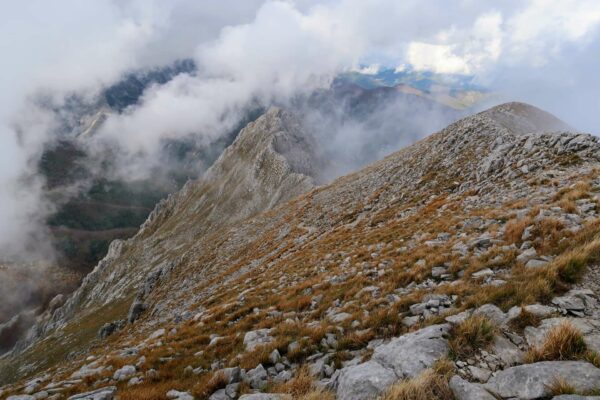
Pania della Croce Hike
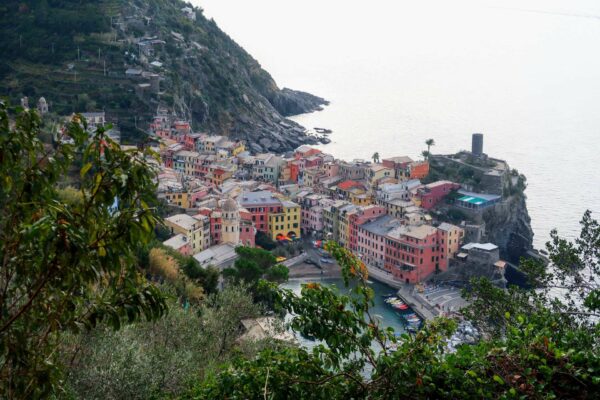
Monterosso to Vernazza Hike

Col Quaternà Loop Hike
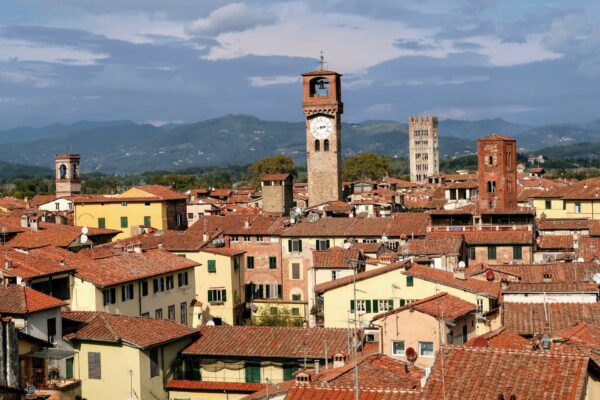
Lucca Walking Tour
Leave a comment cancel reply.
Your email address will not be published. Required fields are marked *
Grumpy Camel
Slow travel & blogging, a complete guide to ostia antica, daniela frendo.
- Last updated 2 years ago
Ostia Antica is possibly one of the most overlooked archaeological sites in Italy.
This ancient Roman port is a treasure chest of well-preserved structures and buildings, which include temples, markets, bath houses, a large theatre and intricate mosaics. Oh, and beautifully intact public latrines, too!
Let’s look at how to visit Ostia Antica from Rome, plus a list of amazing things to see (and do) in this place.

How to get to Ostia Antica from Rome
Ostia Antica is just a 30-minute train ride from Rome. There’s a train station just next to Ostia Antica, and getting there is pretty simple:
- First, get on metro line B and stop at Piramide .
- Walk out of the station and head to Porta San Paolo station, which is next door.
- Get on the Lido train to Ostia and stop at Ostia Antica . Don’t stop at Ostia Lido Nord or Ostia Lido Centro unless you want to get to the beach.

Once you get off the train at the Ostia Antica stop, you’ll need to cross to the other side of the station. Walk over the bridge (you’ll see a sign pointing to the ruins) and you’re there!
Important: Ignore a brown sign which says ‘Passaggio al mare’ (or something similar) as you come out of the train station. It leads to a walking trail along a park and through a forest, and ends at the sea front.
It’s a very long walk to the beach, so if you’re planning to head there for lunch after visiting Ostia Antica, you’ll need to get on the train again.
What to see in Ostia Antica
The great thing about Ostia Antica is that you can explore it at your own pace, without a guide or map.
However, the area is huge and you might not get to see everything if you’re only there for a couple of hours.
Let’s look at some of the best attractions in Ostia Antica.
1. The Mosaics
Ostia Antica is famous for its impressive black and white mosaics, especially those found in the bath of Neptune.

Don’t worry if some of the mosaics are undergoing restoration. There are many of them at the site.
As you’re walking around Ostia Antica, you’re bound to come across more examples of these masterpieces.
2. The Theatre
You can’t miss the Roman theatre in Ostia Antica!
Besides being on the main path from the entrance, it also towers majestically over the rest of the ruins.

Erected at the end of the 1st century BC, the theatre was originally built to accommodate 2,500 people but was later extended for an audience of 4,000.
The theatre is still used for cultural performances.
3. Horrea Epagathiana
This well-preserved Roman warehouse is a remnant of everyday life during the Roman Empire. Back then, Ostia Antica was a hub of commerce and trade.

Niches that once held statues of deities decorate the courtyard.
The black and white mosaic in the courtyard is particularly notable for its depiction of a tiger at the east end of the building and a panther on the opposite side.
4. Capitolium
Another imposing building, the Capitolium is a temple dedicated to the main Roman deities, known as the Capitoline triad (Jupiter, Juno and Minerva).

You can still see the large niches on the side walls where the statues would have been placed.
5. The Castle of Julius
Situated across the road from Ostia Antica, the Castle of Julius II (named after the Pope who commissioned the construction of the fortress) is another site worth a visit.

You can also go for a wee wander around this old part of town.
The houses here are gorgeous, and you can stop for a coffee in one of the cafes nestled in the cobbled alleys.
Where to eat in Ostia Antica
There’s a nice cafe at Ostia Antica. While it’s a bit on the pricey side, the food is quite decent.

Alternatively, you can eat at one of the restaurants and cafes in town. There are some nice ones in the medieval part of Ostia, next to the castle.
Tip: Want to visit Ostia Antica with a guide? Check out this half day trip to Ostia Antica from Rome (by train).
Ostia Antica tickets and opening hours
You can buy your tickets at the door, or purchase them online . At the time of writing, tickets cost 14 EUR per person.
Ostia Antica is open from Tuesday to Sunday (it’s always closed on Mondays). Also, opening times vary according to the season, so you’ll need to check the website before you go.
Frequently asked questions about Ostia Antica
Is ostia antica worth visiting.
Yes! This ancient Roman port is a treasure chest of architectural jewels, and it’s so well-preserved.
What is Ostia famous for?
The mosaics! They’re some of the best preserved mosaics in Italy, and they’re so intricate!
How do I get from Rome to Ostia Antica by train?
First, you’ll need to get on metro line B and stop at Piramide . Then, walk out of the metro station and head to Porta San Paolo train station, which is right next door.
Get on the Lido train to Ostia and stop at Ostia Antica . Don’t stop at Ostia Lido Nord or Ostia Lido Centro unless you want to get to the beach.
Need travel insurance?
SafetyWing provides global travel medical insurance that covers people from all over the world. You can purchase the insurance even if you’re already abroad!
Get your flight, bus & train tickets from one place!
Omio helps you find and compare flights, as well as bus, train, and ferry tickets.
You can manage your trips on the free app. You’ll also get live journey updates!
This post might contain affiliate links. This means that I may receive a commission on any purchases made through the links in the post, at no extra cost to you.
You might also like:

Milan and Beyond: Shopping Guide & Day Trips

Exploring Verona Beyond the Juliet Balcony
2 Responses
Hi! I am planning on going to Ostia Antica this Sunday and was just wondering how you were able to get tickets for the Lido train/how much they cost if you remember. Are there ticket machines at the station or do you have to buy online? Thanks!!
You can buy the tickets from the train station on the day you’re travelling. We bought ours from the ticket office, but you’ll probably find machines at the station as well. I can’t remember how much the tickets were – we visited in 2015!
Leave a Reply Cancel reply
Your email address will not be published. Required fields are marked *
Save my name, email, and website in this browser for the next time I comment.
Notify me of follow-up comments by email.
Notify me of new posts by email.
This site uses Akismet to reduce spam. Learn how your comment data is processed .
© Grumpy Camel 2024. All rights reserved.
Privacy Overview

- All our destinations
- Italy: featured destination
- Ireland: featured destination
- USA: featured destination
- Packing Lists
- Buying Guides
- Booking resources
- Work with me
- Cookies and privacy policy, terms of use
Europe Travel Guides
How to visit ostia antica from rome and why you should not miss it.

One of the most beautiful ancient sites near Rome and a real treat for history lovers is the ancient town of Ostia Antica.
Located just outside of Rome city centre, Ostia Antica is the ancient port of Rome and now has two areas worth visiting: the archaeological park and the ‘ borgo ‘.
This is one of my favorite places in the whole of Italy and one that is really easy to visit from Rome. Here, ancient cobbled roads stretch along rows of pine trees, mosaics embellish the remains of historical dwellings and Roman statues bear witness to the busy life this port city used to be home to.

In this post, I talk about why visiting Ostia Antica and share practical tips on when and how to visit from Rome.
Please note: this post contains affiliate links and, should you make a purchase though them, we might make a small commission at no extra cost to you.
Table of Contents
Is Ostia Antica worth seeing?
The first question I want to tackle about Ostia Antica is whether it is worth making time to visit.
Lesser know than let’s say Pompei, Ostia if often mentioned as an alternative to the most famous roman town and indeed, it is a great place to visit if you want to get out of the city, learn about ancient Rome history but avoid the crazy crowds that swamp Pompeii.
I believe a visit to Ostia Antica is well worth it and I recommend it to history lovers but also anyone who wants to take a break from the Rome busy streets without having to drive or cover long distances.

What is special about Ostia Antica?
Ostia antica is one of the most important archaeological sites in the whole of Italy. Legend tells us that Ostia dates back to the VII century, to the times of Rome King Anco Marzio , but archaeological findings tell us its foundation seems to date between the the VI and III century BC.
The city grew in size and importance and stayed active for centuries.
Nowadays it is one of the best examples of ancient Roman city and one of the best places in the work to gauge how Rome developed and what daily life in this ancient capital looked like.
The main historical characteristic about Ostia antica is that it was a port city. The position on the mouth of the Tiber and on the Thyrrenian coast made it an important hub for trade and saw it growing with populations living together, coming form different parts of the world.
This richness is testified by the many different temples in the city, devoted to deities from as far as Egypt and Persia.
Because of its role in trade, Ostia grew in importance over the course of the centuries and peaked under Emperor Hadrian .
To give you a sense of how successful the city was and how dynamic, Ostia grew to have a population over one million inhabitants! A huge number not juts for ancient cities but modern ones.
Like the rest of the empire, it witnessed the many changes in society Rome saw at this time including the coming to life of ancient Christianity, whose presence is testified in Ostia by several architectural findings.
How long to visit Ostia Antica?
Ostia antica is a short day excursion from Rome: with transport time to and from and a visit to the park and borgo you will need an afternoon to visit.
For the best experience, I recommend you come late morning, spend the afternoon and have dinner in the area.
How to reach Ostia Antica from Rome
Ostia antica is connected to Rome by an efficient train service.
You board the train at the station in Piazzale Ostiense: the ticket is the same you use on Rome buses and can be bough at the ticket teller at the station.
Currently the cost is the same a ride on the metro, 1.50 Euro.Journey time takes approximately 30 minutes and trains are frequent.
In Ostia Antica, the station is just across the road from the archaeological park and the borgo. To reach them you need to cross the road and walk a couple of minutes.

Both the park and borgo and well indicted and visible from the station: you cannot get lost.
How to visit Ostia antica archaeological park: tickets
The ancient site of Ostia Antica is now an archaeological park opened to visitors. At the entrance you have the ticket shop and bathroom facilities and then you pass the official entrance via turnstiles.
You do not need to book tickets in advance and you can get a small leaflet with info or even an audio guide at the ticket stall.
The audio guide is a great resource to understand the park but unfortunately comes with a downside: you need to return it half an hour before the park closes.
This is not a problem if you arrive early in the day but is an issue if you only have the afternoon here: the park is big so once you are back to the ticket office you are unlikely to be able so see much else – meaning you will miss out of the last half hour.
Just take this into account when planning your day here: if short on time, head to the farthest part of the park first and work your way back to the ticket office for efficiency.
Currently the park is open every day except Mondays from 8.30 to 16:30 or 19:15 depending on the time of the year.
Ostia Antica tours?
This post is written with the self guided visitor in mind but, should you prefer to have a guide, there are tours available.
You can meet your guide in Ostia Antica, like in this tour here , or you can opt for one that also included pick up from your accommodation such as this one .
Personally, I find strolling at your own pace more pleasurable but if you don’t like audio guides, which can indeed be fiddly, these are a great option.
What to wear to visit Ostia Antica
The park is an open air archaeological site and visiting requires a lot of walking.
The road are ancient paved Roman roads and are therefore uneven and dusty. You do not need special shoes to walk here, it is not hiking, but it is advisable to have good cushioned walking shoes if you want to protect your ankles from sprains and your toes from pine needles.
You can find my selection of best travel shoes for Italy (including archaeological sites) here
If visiting in any season that is not the heart of winter, do come prepared with layers you can peel off, sun screen and water.
The park has some shaded areas but is mostly under the sun and you will need to protect yourself.
Check my guide to what to wear in Rome in spring / summer for a full list of must haves
Facilities inside Ostia Antica park
Ostia antica is a large park but this doesn’t mean it is devoid of facilities.
Aside from the ticket office at the entrance, which has bathrooms and a small selection of souvenirs, inside the park you have a lovely complex with a good cafe with terrace and a good bookshop and souvenir shop, plus additional bathroom facilities.
The cafe has both an indoor and outdoor area, is family friendly and a great place to relax also with children.
What to see in Ostia Antica park
Ostia antica is all beautiful but there are a few locations that I believe are exceptionally wort seeking out.
Ostia antica theatre
Th theater sits on the right hand side of one of the two main Ostia roads and is one of the first sights you encounter when entering the park
You can access the main stage area or sit on its many steps and it is a wonderful sight.
You can only see ruins of what used to be the scene architectural backdrop but nowadays the beautiful pine trees against the Italian blue sky make it nonetheless a wonderful spot.
This is a great example of Roman theater and while less scenic maybe than the one in Taormina Sicily, is a great pace to see the difference between the Roman take theaters and the Greek style, so well maintained in Siracusa .

Ostia Mosaics
Some of the ancient Ostia antica houses still host wonderful mosaics. You find them in several parts of the park and they are incredible to see, under the beautiful Italian sun.
Unfortunately, lack of information panels mean you cannot understand anything about them without the audio guide but they are nonetheless an easy sight to enjoy.
Mosaics are an ancient form of art and one that dates back to well before Roman times and that came to Europe from the East.
If you have time, I highly recommend you seek them out in Ostia but also in Rome (Santa Prassede or Santa Maria in Trastevere have great examples, find some info about them in my post on Rome hidden gems ).
If you have kids and one extra day, you can even take a mosaic making lab with them: we took it recently (you can read about our experience here ) and it was a very informative and educational, fun activity.

The thermopilum
One of the most impressive parts of Ostia antica is the thermopilus in Via Diana (yes, this is a real city so you get full addresses here!).
The thermopilum is an ancient roman bar: here we can see the main bar serving area, seating area and the outdoor dining space.
While we cannot break bread with ancient Romans, we can sure feel closer to them in a space such as this one, where they relaxed and enjoyed themselves in a way so similar to ours that centuries seem to shrink away.
This is one of the most impressive of all sites: thinking of ancient Romans ordering their drinks or food and then sitting al fresco in the thermopilum patio gives a totally different spin to a society we so often only associated with wars and fighting!

Tips for visiting Ostia antica with kids
We visited Ostia antica with our tow young kids and it was a good day out, albeit tiring for them.
The park is easy to enjoy for children who can run around freely but it requires a lot of walking: make sure you give them good shoes, plenty of water if visiting on a hot day and do plan a stop in the park cafe.
If you have a bay or toddler, I highly recommend you do not bring a stroller.
The old Roman roads are not suitable for buggies and your child would have a super bumpy ride – umbrella strollers with small wheels may even break. If you can, bring a carrier for the day.
There are no storage facilities that we saw but if you make your way to the cafe you may ask if they hold the buggy for you. They might agree but please be advised that it would be at your own risk.
What to see in Ostia antica beside the park: Borgo di ostia antica
Ostia antica is famous for is fabulous archaeological park but there is more to see in it than just roman ruins.
A few minutes down the road you find the gorgeous Ostia antica borgo: this is a tiny area, little more than a square, and develops around the ancient castle.
This is a very atmospheric corner and a photographers’ dream: you can visit the borgo in a matter of minutes or you can stay the evening and have dinner in one of the few but lovely local restaurants. If you do so, I highly recommend the one right in the borgo (you will recognize it thanks to the checked table cloths on tables on the road): if you are unsure what to have, let the owner decide for you – you will not be disappointed!

I hope you found this overview useful and it helped answer the questions: is a visit to Ostia Antica worth is and what is the best way to get there?
We are a participant in the Amazon Services LLC Associates Program, an affiliate advertising program designed to provide a means for us to earn fees by linking to Amazon.com and affiliated sites
Marta Correale
Marta Correale is the creator, writer and creative mind behind Learning Escapes. A travel loving mama of two from Italy, Marta currently lives in Ireland with her husband and two kids, they take frequent trips to European destination, the US and beyond. A professional travel blogger for over a decade, Marta is passionate about traveling with kids and helping others to travel more and better as a family.
Privacy Overview

- The Czech Republic
- Destinations
- Plan My Trip For Me

ITALY , ROME
A complete guide to visiting ostia antica from rome.
What was once one of the biggest and most important ancient ports of Rome, Ostia Antica is one of the best examples of Roman ruins or scavi outside of Pompeii. This vast archaeological site sits just 30 km west of Rome and is one of the top day trips from Rome. Easily accessible by public transport, visiting Ostia Antica from Rome has never been so easy, yet you’ll often find no more than a handful of tourists there.
Over the past 10 years, I have visited Rome over 20 times. But it wasn’t until 2018 that I discovered or had even heard of the Roman ruins of Ostia Antica. Sat just 30 minutes west of Rome close to the seaside town of Ostia, this archaeological gem is not only one of the best Roman ruins in Italy outside of Naples, but it is one of the most fascinating, giving a real insight to how Roman’s lived 2000 years ago and how important Ostia was to the growth, sustainability and daily life of Rome.
When I visited in June 2018, I found to my surprise only a handful of tourists there. I spent an entire day wandering around the ruins of Ostia in amazement and awe. How is it that Pompeii is crowded with hundreds of people every day and this historic wonder lies just a metro ride away from Rome and there be just a single school group and a few tourists on one of the sunniest and warmest days in Rome in June?! I still find it hard to believe 2 years later that few tourists make the short journey to visit this amazing site and what I consider the most underrated and underappreciated sight I have yet to visit in all of Italy. If you happen to stumble across this post, I hope that you find the below guide useful in planning your trip to Ostia Antica and that you enjoy your day exploring the Roman ruins and this ancient Roman port!
Table of Contents
Brief history of Ostia Antica
As the main harbor city of ancient Rome, Ostia Antica was once a thriving seaport home to over 60,000 people. The name Ostia derives from the ancient city’s position at the mouth of the Tiber River. Ostia in Latin – ostium – means river mouth in English.
Founded around 620 BC, Ostia was one of the very first Roman colonies to be built on the banks of the Tyrrhenian Sea. Situated next to salt flats, Ostia supplied large quantities of salt to the Roman Republic, a precious commodity in ancient Roman times, used to preserve meat.
Around 400 BC, Rome took over Ostia and formed a naval base there and by 150 BC Rome pretty much ruled and controlled most of the Mediterranean and Ostia became is main commercial port. At its peak, Ostia was vital to the Roman Empire. Most of Rome’s imports, meat and goods came through Ostia and was transported into the city by horse and cart.
Overtime, Rome began to depend on other ports around the Mediterranean, and Ostia lost is status. It became the epicenter of Malaria causing inhabitants to flee for their lives and with the fall of Rome, the port town of Ostia was abandoned and forgotten about. Eventually, the harbor silted up and it was thanks to the large amount of mud which eventually buried Ostia that many of its buildings and mosaics were protected from the ravages of time.
How to get to Ostia Antica from Rome
Getting to Ostia Antica from Rome is very easy by public transport. To visit Ostia Antica from Rome, you need to take a ride on the metro and then a short train ride.
Taking the train from Rome to Ostia Antica
You will most probably start at Roma Termini Train Station where you’ll find the Red and Blue Metro lines.
You will want to go down into the metro and take the Blue B Line traveling in the direction of LAURENTINA and ride to the PIRAMIDE station. When you reach the Piramide train station, step off the train and look to your left. Follow the signs to Lido (beach) — go up the escalator, turn left, and go down the steps to reach the Roma-Lido train line. Then wait for the next train departing in the direction of Lido. Trains leave every 15 minutes and they stop at Ostia Antica along the way (7 Stops).
When you get to Ostia Antica, exit the train station and walk directly ahead to the blue pedestrian bridge. Cross over the bridge and walk straight down the street and then walk through a small parking lot. You’ll eventually reach a larger parking lot where you’ll see the entrance to the site and the ticket office to your left.
What public transport train tickets will I need to travel to Ostia Antica?
If you have purchased a Roma Pass then your travel to and from Ostia Antica is included. You will just need to tap the pass on the metro ticket gates to validate your journey.
If you need to purchase a public transport ticket to get to Ostia, I suggest purchasing a standard single ticket for €1.50 for a one-way journey or a 24-hour pass for €7 which will cover your return journey as well as any other transport you may choose to use that day (for example to return to your hotel or visit other sites).
Ostia Antica Opening Hours and Admission Fees
Tickets can be purchased on the spot at the archaeological site from the Ticket Office. You can also purchase tickets in advance online here however they do charge a €1 admin fee.
Roma Pass holders can enter for free using one of their included museum passes. If you have a 48 hour Roma card then you have 1 free entrance included. For 72-hour cardholders you have 2 free entrances included.
OSTIA ANTICA OPENING HOURS 2020
Open: Tuesday to Sunday
Closed: Every Mondays, 1st January, 1st May, 25th December
Opening Hours:
- 8.30AM – 4.30PM (25th October – 28th (or 29th) February, last entrance at 3.30PM)
- 8.30AM – 5.15PM (1st March – 31st March, last entrance at 4.15PM)
- 8.30AM – 7.00PM (1st April – 30th September, last entrance at 6.00PM)
- 8.30AM – 6.30PM (1st October – 24th October, last entrance at 5.30PM)
The Ticket Office and the Museum close one hour before the site’s closing time. For an up to date schedule of opening times you can check the official website here .
As a containment measure for the spread of COVID-19, many of the cultural sights in Italy are closed. Ostia Antica is currently closed due to the Coronavirus until the 3rd April.
Is Ostia Antica worth visiting?
, In my opinion, the scavi ruins of Ostia Antica is one of the top day trips from Rome.
It is a cheap, educational and fascinating day out and a peaceful retreat from the hustle and bustle of Rome. If you haven’t made it to Pompeii but are visiting Rome, Ostia Antica is a must-do day trip! The crowds of tourists have yet to discover Ostia Antica so you’ll often find you’re walking down an ancient cobbled street all by yourself.
Ostia Antica VS Pompeii? Which is better?
While the story of Ostia Antica isn’t as dramatic as Pompeii, Ostia Antica shows a more in-depth and real side to the everyday life of the Romans. The mosaics alone are worth the trip!
Ostia Antica also has far fewer crowds than Pompeii and is a short 30 minutes from the city. To travel from Rome to Pompeii is an almost 3 hour journey time.
What is there to see and do at Ostia Antica?
The archaeological site sprawls over almost 10,000 acres so there is plenty to keep you busy for an entire day. Excavations of the ruins began in the late 19th Century and most of the ruins have been uncovered for you to see including some incredible mosaics, temples, public baths, latrines, and stores, giving you a true insight to everyday life as a Roman.
Since there is so much to see, I have listed below a few of the top highlights of Ostia Antica that you should definitely seek out during your visit. The city is laid out following one long main street called Decumanus Maximus . Use this as your main artery for navigation during your visit. On the map below, you’ll see the entrance to the site on the right and the main street running through the middle. I’ll list the sights worth seeing in order, from the right entrance to the left.
You can purchase the same map of Ostia Antica on arrival at the Ticket Office. I found it extremely useful during my visit to identify which ruin was what. There are also very good signs in English explaining each ruin in detail as you walk around.
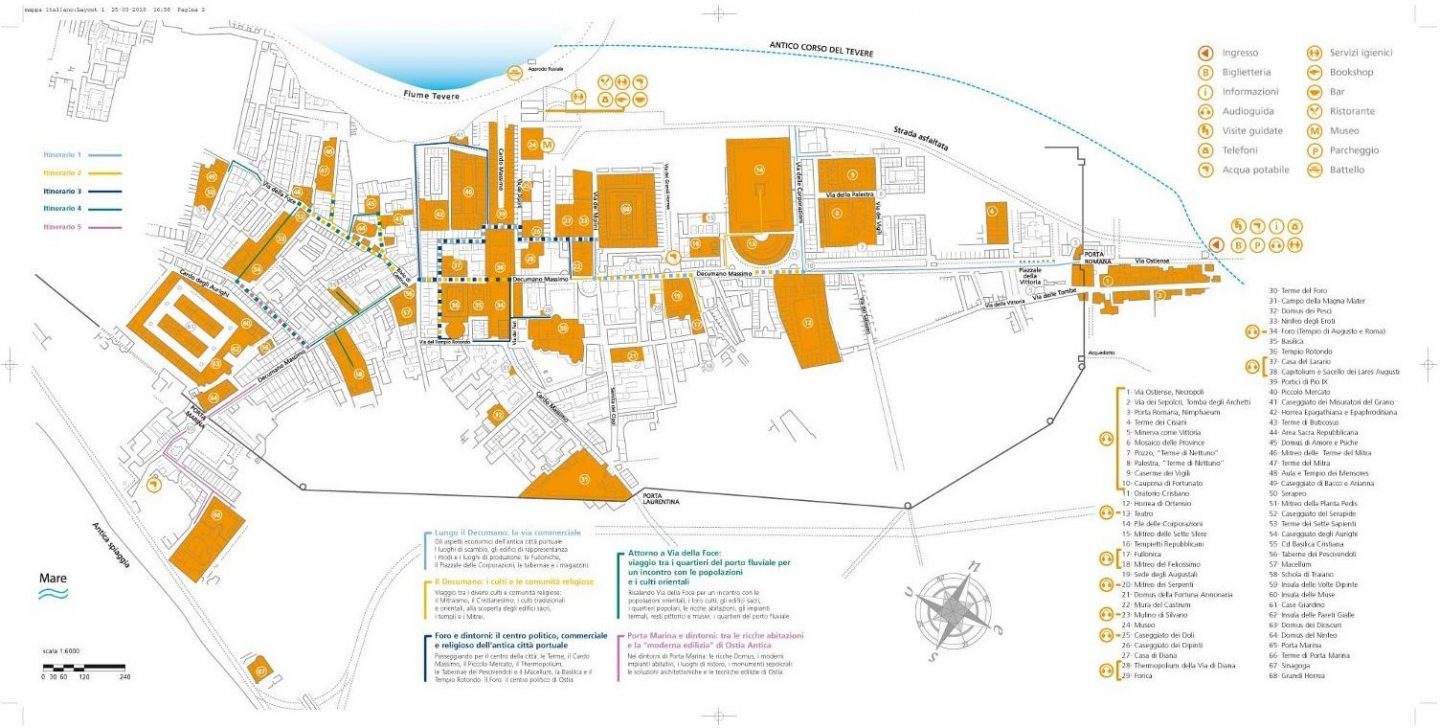
The Necropolis
The Necropolis is one of the first sights you will come across on your left as you enter the archaeological ruins. The Romans believed that the dead should be buried outside of the city walls. This was to avoid any contamination or disease spreading inside the city. It also forced anyone who was passing through the gates to and from the city to acknowledge the ancestors. Both burials and cremations were practiced in Roman times and you’ll find a mixture of open tombs and sarcophagi which has some scriptures inscribed on them. It is said whoever disturbs the tombs will be cursed.
Baths of Neptune
Roman bathhouses used to be the epicenter of all social interactions within the city. Covered in marble, beautiful statues, fountains and mosaics, they were a place not only for bathing but for exercising and socializing. Climb up the steps to the viewpoint over the well-preserved mosaics of the Baths of Neptune, where you’ll see Neptune himself riding four horses through the waves.

Teatro of Ostia
The grand theatre of Ostia is a sight you can’t miss. Built in the 1st Century BC, it could hold up to 4000 people. Most of the theatre’s structure remains visible, and you can climb to the top level (where women would have typically sat thanks to the gender division rules of Ancient Rome) to get a good overview. Musicians typically performed in the ground floor semi-circle, while actors would have used the wooden stage.
Plaza of the Guilds
The large square located behind the theatre is the grand square of the guilds. This was once the heart of Rome’s import and export industry. It is here that merchants from foreign lands would gather to sell anything from grain and shipping services to elephants and giraffes. The most notable detail of the Square of Guilds is the intricate black and white mosaics that lie in front and inside of each shop. These mosaics indicated the professional associations of each vendor. It is important to note that these shops did not have any merchandise in them (they were too small). Instead, they functioned more as offices where people could meet and create deals.

The Grand Horrea
The Grand Horrea was built to store grain. The storage capacity of the ground floor alone was said to 5 to 6000 metric tons of grain. It has been estimated that 150,000 tons of grain were needed each year to feed the Roman people. If that’s correct, this granary held only 4% of the grain needed to feed Rome.
The Mill of Silvanus
Dating back to 120 AD, the Mill of Silvanus is a great example of a Roman bakery. You can still see the lava millstones and the well-preserved bread ovens.

Via Casa di Diana
There are a few important sites grouped together which include the House of Diana, the Thermopolium and the House of the Paintings. The House of Diana is a great example of how the lower middle class lived while the Thermopolium is one of the best sights in Ostia. Here you get a real vision of what a bar used to look like in the Roman times, complete with an intact bar, a menu on the wall, shelves and wall paintings.
The Capitolium and Forum
The next collection of ruins are all linked to the Forum that dates back to the era of Hadrian. It was the religious and administrative center of the city and was also a location for the locals to come together for a chat, a prayer, a debate or even a bath. In fact, the Forum is the heart of every Roman city and you can’t miss visiting Ostia’s. At its heart of the large Capitolium, Ostia’s largest temple.

The Fishmongers
Another favorite sight of mine and almost immediately recognizable is the Fishmongers. It is marked by a marble table, a fish basin at the rear and a mosaic fish on the floor.
The Latrines
Probably the most famous ruin and one that almost anyone can recognize are the Latrines or what we call the toilets. These toilets were public toilets open to anyone. The running water underneath would wash away any waste and there would often be a communal sponge that was used to clean themselves. Gross right?!
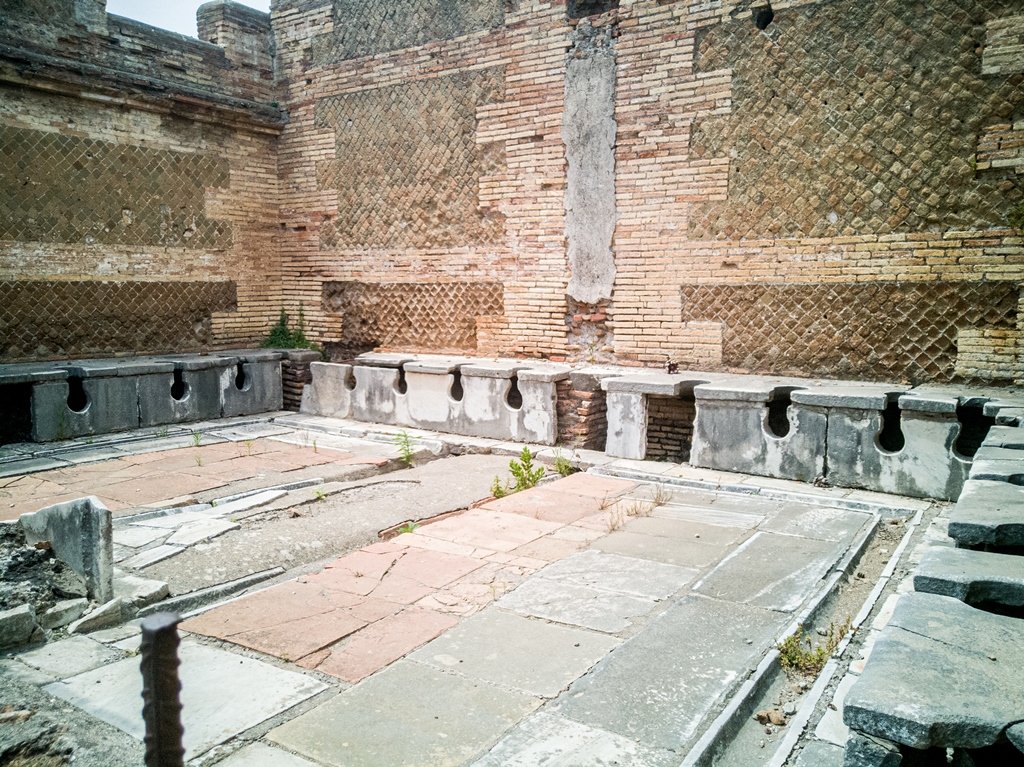
Ostia Antica tips for visiting and common FAQS
Ostia Antica is a very big archaeological site and you can easily spend the entire day there. Below are some top tips for visiting the Ostia Antica scavi ruins including important things to bring with you as well as some answers to common questions about visiting Ostia Antica.
The scavi ruins have many loose cobblestones and rocks and the site is extremely dusty so suitable shoes for walking are highly recommended. A sun hat is also recommended. When I visited in June it was 30 degrees and in certain areas, there is very little shade. A water bottle will be useful as water in the restaurant is very overpriced. And an obvious one, bring your camera!
There is a restaurant there located next to the museum. I found the food and water to be very overpriced for what was being served, so if you’re traveling as a family, a packed lunch maybe a better option. At the time of visiting, it was possible to sit amongst the ruins to eat my packed lunch. That is a pretty incredible experience in itself!
Ostia Antica is located just 5 km from Rome’s Fiumicino airport. You can easily take a taxi there from the airport which will cost you approx. €30-40 or $35-45 one way.
As of March 2020, there are no facilities to store your luggage at Ostia Antica. It would be best to store your luggage at your hotel or at the main Termini rail station.
Pin this post
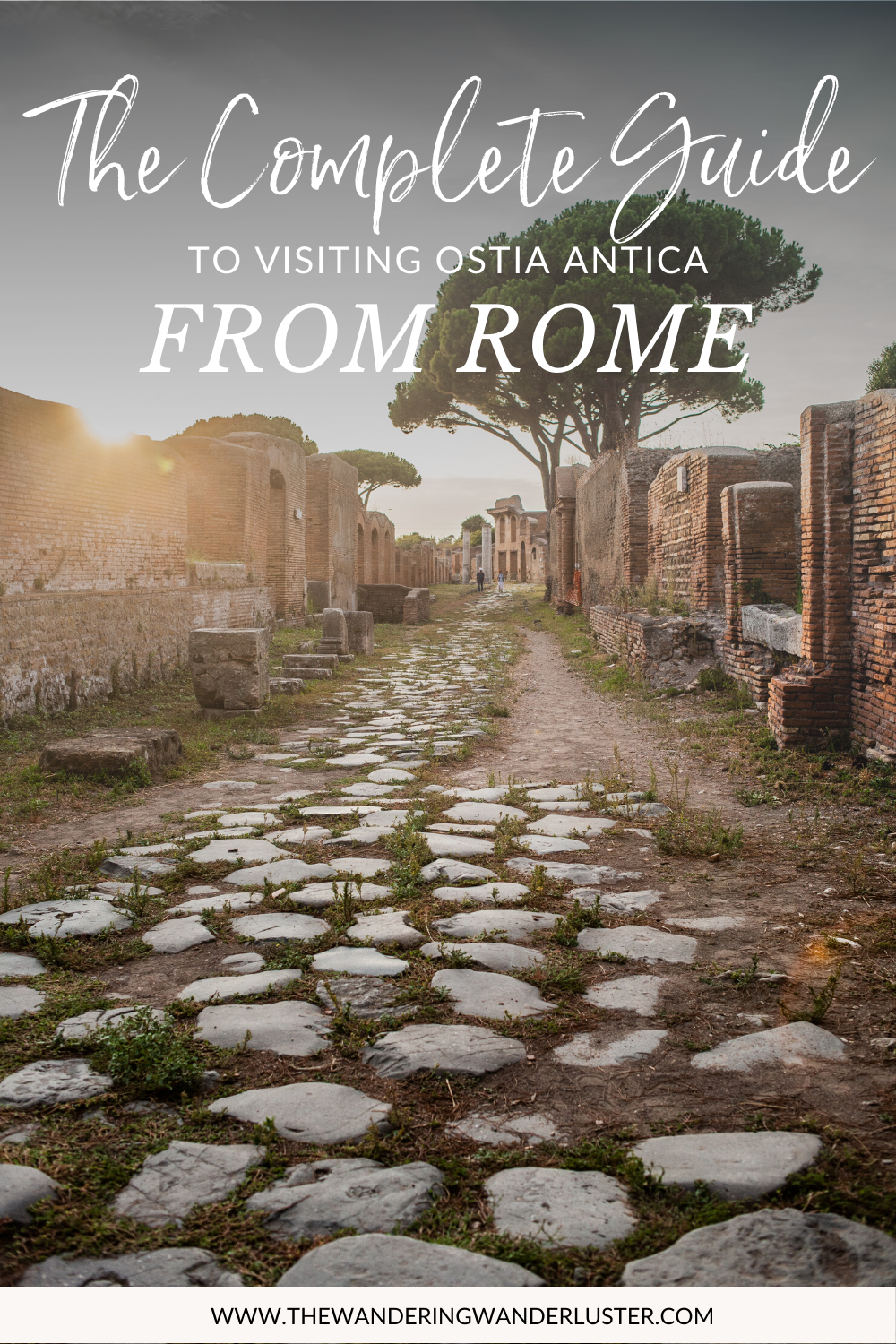
2 thoughts on “ A Complete Guide to visiting Ostia Antica from Rome ”
Thank you for the great information
We were to visit and stay in Ostia, until covid cancelled our trip. Will re do in Late 2021.
Leave a Reply Cancel reply
Your email address will not be published. Required fields are marked *
- Search Please fill out this field.
- Newsletters
- Things To Do
Ostia Antica Travel Guide
:max_bytes(150000):strip_icc():format(webp)/james-globe-56a3a1c05f9b58b7d0d2e4e5.jpg)
TripSavvy / Christopher Larson
Legend has it that Ostia Antica was founded at the mouth of the Tiber in the 7th century BC by king Ancus Marciusto to protect Rome from attacks coming via the sea. Once established, the port took on commercial functions associated with supplying Rome with food. Like many ports in ancient times, the silt from the river eventually silted up the port and now Ostia Antica sits 3 km from the sea.
Ancient cities more famous for tourists to visit Pompeii and Herculaneum in Campania were mainly tourist resorts for the rich that got flattened by a volcanic eruption. A visit to Ostia, however, gives the visitor a better idea of how Romans built cities. You can visit a bakery that served bread to thousands, or a set of public toilets that served dozens of bread-bloated Romans at a time.
Preservation of Ostia Antica is very good. You'll be able to climb to the top of apartment buildings called insule to peer down into street-level bars and snack shops. Ostia is rather like a ghost town abandoned in recent times, as you can see from the picture above; you can almost imagine the people in the picture coming home from work. In reality, the site was abandoned by the 5th century, a victim of the silting up of the harbor and more functional ports built nearby.
At the time of writing, a single 1.50 euro metro ticket will get you from central Rome to the excavations at Ostia, where a ten euro ticket will get you into the site. We'll tell you exactly how to go about getting there on the last page of this guide. And be very aware: the site is closed on Monday, although much of what you see on the web will not inform you of this important fact.
Communal Toilets at Ostia Antica
TripSavvy / James Martin
Ok, so we figured you're most interested in seeing the picture of Ostia's famous communal Toilets. Well, there you go.
The toilets at Ostia are of marble and line three sides of the enclosed space. A trough in front of the line of toilets was for the communal sponge, which would be "cleaned" by a stream of water running through (or, as Roman Baths and Hygiene in Ancient Rome suggests, perhaps it is a holding place for the sponge, which was washed by slaves in vinegar). Slaves also could be employed as seat warmers.
An intimate look at ancient Rome provides an interesting peek at ancient toilets and latrines, and points out that there is an early version of a flushing toilet we missed in Ostia, inside the House of Fortuna Annonaria.
The Bakery at Ostia Antica
Here we find ourselves in one of Ostia's bakeries, where wheat was brought in and milled in the device you see here, driven by a horse or donkey and turned into flour. The room is designed with high windows in an attempt to diminish some of the flour dust which would have contributed to miserable working conditions. There are also quite clever kneading machines in Ostia.
If you are interested, a fine description of the bakeries of Ostia and free bread distributions is found at The mills-bakeries of Ostia and the distributions of free grain. If you prefer, there is an excellent video by the same author, Jan Theo Bakker: Ostia explored 2. A Roman bakery explained , which shows the kneading machines and how they worked.
The Roman Theater
Ostia's theatre was built along the Decumanus Maximus, Ostia's main street, between 19 and 12 B.C. It could seat 3 to 4 thousand people.
More information on the theater is found here: Regio II - Insula VII - Teatro (II,VII,2) .
A Street in Ostia Antica
There are many, many streets and alleys to walk on a visit to Ostia Antica. Tours hit only the highlights; there are surprises hidden everywhere. A two-hour visit scratches the barest of surfaces—allow at least four hours to see the highlights.
There's a cafe and bookshop on the northern boundary of the site where the Tiber is visible. You might also want to bring your own food and eat at the small picnic area (or buy a drink and sit at the cafe tables).
You can get a free map with your ticket. It shows how extensive the excavations of Ostia have been.
Getting to Ostia Antica
A metro ticket can be purchased in bars or newsstands. You can also purchase them on the trams, but you'll need change rather than bills.
To get to Ostia Antica, take the tram, bus, or Metro line B to the Piramide stop. Exit the metro, turn left and look for the Porto San Paolo station, where you’ll see a different set of tracks. These are trains heading to the beach, Roma-Lido. The stop for Ostia Antica is before the last Lido stops, as Ostia Antica is now inland, as you know.
Once you've departed your train at the Ostia Antica stop, take the stairs down that get you across the tracks, head straight out the station and over the blue pedestrian bridge, where signs will lead you to the excavations.
If it's lunchtime you might consider heading over to the castle and borgo, where there are several restaurants. On Sunday at 11 and noon, you can visit inside the castle free, which is worth doing. It's an accompanied tour, not a guided one, so your questions might not be answered, but you can let your mind loose on what you see--especially upon encountering the Pope's Bath on the lower level.
A very good and inexpensive restaurant is Ristorante Cipriani , which serves a typical Italian two-course meal with water and coffee for a mere 10 euros. Not those gargantuan portions like you get these days, but Roman food com'era , like it was before tourists demanded a pasta course that filled them up. Our meal featured a small portion of pasta followed by a fish dish of reasonable size to just fill you up satisfactorily. Congrats to Ristorante Cipriani for pulling off what certainly was a bargain delight, which included on our visit a house-made tonnarelli (pasta) with shrimp. Add 3 euros and you can have a very decent half-liter of wine.
Finally, The Via Ostiense links Rome to Ostia. It starts at the Porta Paolo, one of the ancient gates that is an entrance to Rome from Ostia. The gate actually a museum these days which explains the whole route along the via Osiense. You can explore the Roman end of Via Ostiense with our guide: Itinerary: Museo Della Via Ostiense to the Basilica of St Paul Outside the Walls.
Related Articles
More related articles.

Visit Ostia Antica
Visite Guidate a Roma
Tour to Ostia Antica, Portus and Roma.

Discovering places…
Extraordinary
With our tour guides you will live unforgettable experiences thanks to the fascinating history of Rome.

Guided tours
Why choose us
Expert guides.
Who better than an inhabitant of Ostia Antica can tell you its secrets? Our licensed tour guides - archaeologists, historians and art historians - are all local guides.
Five languages
Is Italian not your language? No problem! We offer all our tours in English, German, Spanish and French as well.
Maximum flexibility
Special timetable requirements? Last minute tour? Our team is ready to meet your requests
Personalized experiences
Do you want to visit archaeological treasures off the beaten track? Do you want to give a unique experience? Our guides can organize tailor-made tours for you.

Tips and events
Privacy Overview
- Italiano ( Italian )
- In the Press
- Work with us
- Rome & Vatican Rome Vatican Colosseum Rome Food
- Italy Florence & Tuscany Venice & Northern Italy Pompeii & Herculaneum Amalfi Coast & Capri Naples & Southern Italy
Ostia Antica Tour: The Perfectly Preserved Port of Ancient Rome
Discover one of the ancient world's best kept secrets on a special day trip to Ostia Antica from Rome
Starts from 795 €
(16 Reviews)
- tour overview
- tour description
- tour reviews
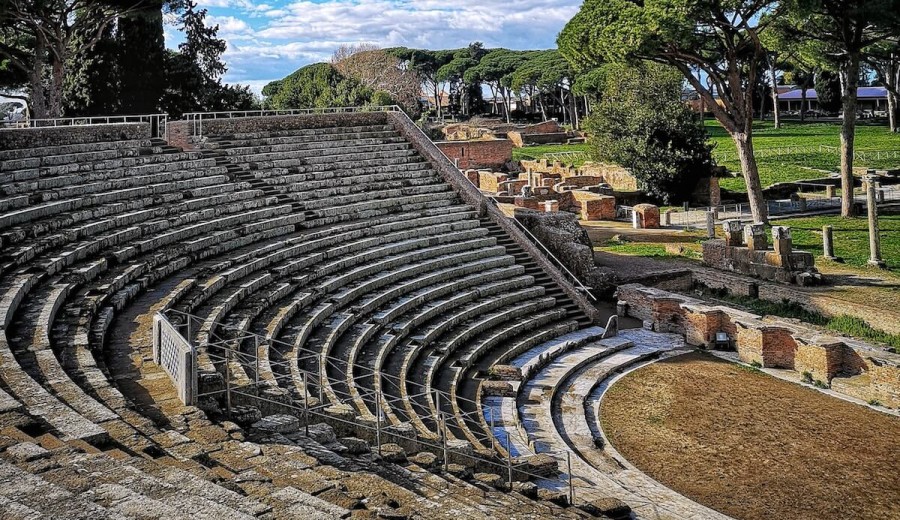
starting time Variable
duration 5 hours including travel
Tour Overview
Embark on a fascinating voyage back in time on our Ostia Antica tour, and explore the magnificently preserved remains of the Roman Empire’s most important port. Just half an hour from the Eternal City by train, the vast ruins of Ostia Antica rival Pompeii for their size and incredible state of preservation - but without the crowds! Spectacularly sited in the Roman countryside surrounded by umbrella pines and swaying cypress trees, learn why the harbour city of Ostia was a vital cog in the massive machinery of the Roman empire. Wandering through buildings still rich with the traces of everyday life and decorated with wonderful mosaics, frescoes and statues, discover what it was really like to live in an ancient Roman town over two millennia ago. The awe-inspiring archaeological park of Ostia Antica is still far from the usual tourist itineraries, but it won’t stay under the radar forever - book your Ostia Antica tour today and discover the ancient world’s best kept secret!
- Entrance tickets to Ostia
- An expert English-speaking private guide
- *does not include train tickets (€1,50 one way and to be paid directly at the station when you depart)*
- The House of Diana
- The Theatre of Ostia
- The Temple of Venus
- The Baths of Neptune
Tour Description
Explore the magnificently preserved remains of Rome's ancient port
The ancient ruins of Ostia are beautifully located in the Lazio countryside, and no modern buildings obscure the magical remains. On our private tour of Ostia Antica, you can wander through this beautiful maze as if discoverering it for the first time.
The ancient Roman port city of Ostia Antica is only a half-hour train journey from Rome. Though it used to be on the sea, a build-up of silt over the centuries means that it now lies three kilometers inland. It was this sand blowing in gradually from the coast that has preserved the city so well for us today. 'Ostia' means 'mouth,' and refers to this city's important position at the mouth of the Tiber River. As Rome grew in importance Ostia grew with it, turning into a thriving port city of 80,000 inhabitants in its Imperial heyday. The city was very well connected to Rome by the river Tiber as well as the ancient roads of Via Ostiense and Via Portuensis, the busiest in the Roman Empire.
Wander through the ancient cemetery on the outside edge of the city walls, where columbaria and elaborately decorated sarcophagi held the remains of important families. From here we will follow the ancient basalt road through the city entrance where twin colossal statues to the goddess Minerva guarded the entry gates. At the Baths of the Cart drivers we'll admire whimsical mosaics showing portraits of the drivers' favorite mules along with inscriptions relating their affectionate pet-names.
From here we will head to the Baths of Neptune , where we'll learn all about ancient bathing customs and their importance to Roman ideals of civilised behaviour. Amazing mosaic floors showing the god Neptune along with mermaids and other mythical sea creatures are on display here, which we can view from the second storey of the bath complex.
One of the most important features of Ostia were the warehouses that stored goods imported from all over the Roman Empire. With such a concentration of produce it became necessary to guard against potentially devastating fires, and so the Emperor Augustus established a Fire Station which we can still visit today. We will see its important Altar to the Emperors , as well as its bathroom with marble seats and coved ceilings. After passing a row of shops we will step inside the Tavern of Fortunatus to see the floor mosaic that welcomed his guests with the greeting "Fortunatus says if you are thirsty, drink wine from the crater." The accompanying picture of a giant drinking goblet drives the innkeeper's message home.
Our private Rome tour will take you to the beautiful Roman Theatre from the first century B.C., used today for evening concerts in the summer. Here up to 4,500 people were seated and entertained with tragedies, aquatic shows, music and bawdy comedies. Behind the theatre we will explore the Square of the Corporations , a rare site surrounding the Temple to Venus which housed the offices of merchants decorated with mosaics displaying their vocations, ranging from the transport of wheat to live elephants.
After, we will continue with a visit to the small museum of Ostia Antica, with displays of many sculptures and frescoes found on-site. Next an intriguing visit to the Thermopolium, an ancient bar and restaurant that looks almost as if it could still be serving food today. Across the street we will see the famous House of Diana , one of the most important surviving apartment buildings from ancient Roman times. After visiting a bakery and seeing a field of giant pottery containers for oil and wine, we will arrive at the Curia and the Forum - the civic heart of Ostia and site of the temples to Hercules and the Goddess Roma .
Along the way we will see temples to the most important gods and goddesses of the ancient world, including a field dedicated to the worship of the great mother goddess Cybele, many Mithraic Temples as well as a rare Jewish Synagogue and an important Christian site. At the end of the tour we will visit opulent Pompeii-style houses complete with beautiful interior courtyards and statues, as well as the impressive Baths of the Forum. These baths were famous for their delicate design which followed the path of the sun, their large Corinthian columns, a hexagonal gymnasium and public men's and women's bathrooms.
After an exciting day visiting these wondrous sites on this special ancient Rome private tour, your guide will return with you on the train to the meeting point.
meeting point
Tour Reviews
5.0 (16 reviews)
We took a private tour of Ostia Antica and it was the highlight of our trip. Our guide, Brandon from Canada, was incredible. He is highly knowledgeable in archaeology, history, and the classics. He is a PhD candidate who studies the area. He was funny, and relatable and provided us with the best tour (and we take a lot of tours) of our 4-week trip. Thanks, Brandon! Michelle, Kate, and Shawn
Discover737045 - May 02, 2024
When we arrived by subway to the meeting point, we easily found Guia waiting for us with a Through Eternity sign. She expertly guided us through the commuter rail system to Ostia. In January 2023, we had the archaeological area almost to ourselves, so it was easy to imagine the different neighborhoods as Guia described them to us. Our group included one historian, one retired microbiologist, and one 19-year-old firefighter trainee. Despite our divergent perspectives, Guia ably fielded all of our questions, frequently placing her answers within the larger contexts of her knowledge of antiquity and art history. We got a whole new perspective on trade and social dynamics in ancient Rome. We especially appreciated Guia's special effort to show our son the fire station of ancient Ostia and engage him with the details of Roman firefighters' lives and firefighting techniques. Guia offered suggestions for our later sightseeing in Rome and shepherded us back to Rome at the appointed time as the trains began to fill with afternoon commuters.
Cynthia - Jan 05, 2024

Subscribe to our newsletter and receive 5% off your first booking!
You'll also receive fascinating travel tips and insights from our expert team
Subscribe to our free newsletter
Thank you for subscribing!
You should shortly receive a confirmation message with your discount code. If you do not receive this within 5 minutes, please email [email protected].
Semi-Private Ostia Antica Half-Day Tour: An Ancient Roman City Frozen in Time
- With round-trip transportation included in your booking, revel in the chance to discover Ostia Antica ; you’ll travel here, in a group of 12 or fewer , from Rome by train with an open return ticket meaning you can explore at your own leisure!
- Travel back in time on this half-day tour and find out what life in ancient Rome was really like as one of Italy’s most accessible and well-preserved archaeological sites .
- With an expert, English-speaking guide accompanying you you’ll hear stories that bring the Port of Ostia Antica to life; from Roman baths to ancient roads and grain trade, there is a lot to discover here…
Tour Description
What's included.
- Small groups of 12 people or less
- Train ticket to and from Rome
- Ancient Ostia entrance ticket
- English speaking tour guide
Sites Visited
- Ostia Antica
- Baths of Neptune
- The main street Decumanus Maximus
- Ostia’s Amphitheatre
- Forum of the Corporations
- The Collegiate Temple
- The laundry shop and public bath
On this half day Ostia Antica tour from Rome you will see and enjoy intriguing tales on everything you have come to love about the Romans of antiquity in a beautiful natural setting away from the traffic and noise in the city center. Your expert City Wonders guide will bring history to life before your very eyes as you stand where its ancient inhabitants stood, so don't be surprised if you hear echoes of the past!
See What Life Was Like In The Roman Empire From The 4th Century BC s
At Ancient Rome's port city you will travel across millennia into a detailed photograph of what life was like in the Roman Empire from the 4th century BC until the town was slowly abandoned. Leave modernity behind as you trace the grooves of chariot wheels on the original road leading into the settlement, which once had a population of some 50,000 people, mostly stout sailors, dock workers and wealthy merchants from all over the Mediterranean.
Expert English Speaking Guide
Ostia Antica was the main point of entry for all the goods that came into Rome from the Empire, and was the city's bread basket for grain coming in to feed the capital's huge population. This trade created opulent wealth, the signs of which are clearly evident today.
Listen as your guide provides a captivating account as you marvel at its amphitheater, impressive temples, insula apartment blocks and the Forum of Corporations, where everything under the sun was bought and sold.
Extensive Baths Complex
Additional highlights of the Ostia Antica tour include the extensive baths complex, with its thermodynamic systems still largely intact, and an almost perfect example of what dining out was like 2,000 years ago.
The site is also home to some of the finest Roman mosaics that survive in their original positions, crowned by the world-famous image of Neptune driving his chariot of seahorses. The grounds also feature examples of period statuary and you can hunt for the elusive Ostia lighthouse, which archaeologists still haven't found.
Ready to plunge into ruins that rival those in Pompeii and Herculaneum? With our masterful guide and carefully planned itinerary, your journey back to Rome will feel more like time travel after this fun and informative tour.
Thousands of 5-Star Reviews
Tripadvisor, know before you go, meeting point.
Cafe Piramide - Open in Google Maps
Important Notes
- Children under the age of 18 might be requested to show their ID card at the entrance of the site, so please bring it with you on the tour.
- While our day trips are typically of a fixed duration, external factors may occasionally extend tour times slightly. We appreciate your understanding and planning as we strive to provide you with the best possible experience.
Cancelation Policy
This tour is subject to a 24-hour cancelation policy. If you wish to cancel or amend your booking, you can do so without charge by contacting us up to 24 hours in advance of your expected departure time.
We are happy to assist with this request - availability permitting. Please contact our Customer Care Team who can check availability on the tour and take payment for the additional booking, as payment details are not saved in our system for security reasons.
We strongly advise against arriving at the meeting point without a booking as we cannot guarantee that there will be space left on the tour. Our guides are unable to accept payment for tours so any bookings made on the spot will still need to be processed over the phone with payment by credit card.
To change between currencies, you just need to scroll to the top of the page and look at the banner - you should see an icon of a flag displaying the language you're viewing the page in, and beside that there will be a small symbol depicting the currency. Click on this and you'll be able to change between them.
- Book with Confidence: Free cancellations up to 24 hours before the experience begins (local time).
- Multilingual Customer Service: Talk to us, we are here to help.
- No Hidden Costs: All taxes and fees included.
You Might Also Like...
Semi-Private Vatican Museums, Sistine Chapel & St. Peter's Basilica Tour
Tuscany Day Trip from Rome with 3-Course Lunch and Wine Tasting Included
Pompeii & Mt. Vesuvius Volcano Day Trip from Rome with Authentic Neapolitan Pizza Lunch
Day trips from rome, get to know city wonders.
A City Wonders tour is the product of meticulous research, detailed planning, and a passion for providing customers with travel experiences they will cherish forever.
With City Wonders it's not just facts, our passionate guides tell you the stories that bring the sights to life.
- All of our guides are experts in their field
- We only hire fluent English-speakers so nothing is ever lost in translation
- We focus on the little details and anecdotes that make City Wonders so special
Recommended Rome Posts

- Herculaneum
- Rome Food Tour

Welcome to Ostia Tours!
We organize private and small group tours of Ostia Antica and Italy. You will not stand in lines. You will not be bothered by large groups of people. You will love our services!
Get a Free Quote
OUR TOURS IN OSTIA ANTICA
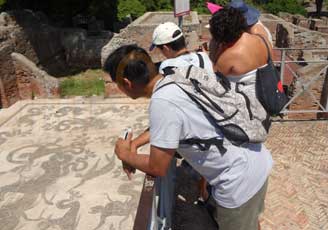
Best of Ostia Tour (3 hours)
- Around Rome
Guided visit of Ostia Antica, the oldest and best preserved port town of the Roman Empire. Read More...
OUR TOURS IN THE REST OF ITALY
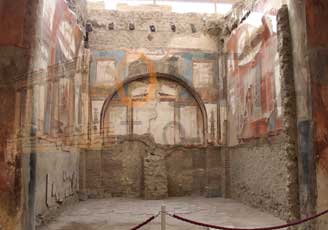
Herculaneum Tour
- Around Naples
This guided walking tour of Herculaneum is a trip back in time. In 79 AD, Mt. Vesuvius erupted, burying Pompeii and its lesser-known neighbor, Herculaneum. Read More...
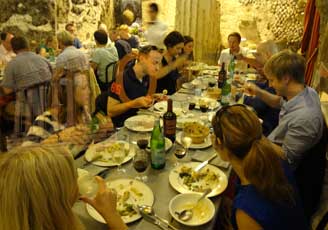
Rome by Night Food Tour
This historic walk and dining excursion will introduce you to the Campo Marzio neighborhood, the oldest Roman district, its restaurants and celebrated sites. Read More...
Trip Advisor Review
- 2 reviews of Ostia Tours - Ostia Antica Tours in Lazio
- Facebook: facebook.com/ostiatours
- Phone: (+39)371 395 9933
- Email: [email protected]
- Monday - Sunday: 8:00 am - 7:00 pm
Send Us a message


IMAGES
VIDEO
COMMENTS
Ostia Antica is connected to Rome city center by a frequent commuter train. The train leaves Roma Ostiense station at regular intervals (up to 12 time per hour) or so and the ride takes approximately 30 minutes. This train is part of the Rome public transport network (you can read our full guide to getting around Rome here) and you need the ...
Here, take the Roma Lido commuter train to Ostia Antica. Once at the station, all you have to do is follow the crowd. It is a 10-minute walk away. The train to Ostia costs € 1.50 (US$ 1.70) (like any other one-way journey). Since you are going to use quite a lot of public transport, you might want to buy a day pass.
Free First Sundays. Every first Sunday of the month free entrance for Archaeological area of Ostia antica, Imperial harbours of Claudius and Trajan, Museum of Roman ships, Necropolis of Portus, Julius II Castle. Free entry on April 25th, June 2th and November 4, 2024. Archaeological Park of Ostia Antica OPENING HOURS. Open: from Tuesday to Sunday
Official website of archaeological park of Ostia Antica. Free admission. EU citizens younger than 18 years old; Disabled visitors and their carer; Non-EU citizens on a condition of reciprocity (children younger than 12 years old must be accompanied by an adult); EU licensed guides, if leading a group and after showing valid license; EU licensed guide interpreters, if accompanying a guide and a ...
Or: download our free Tourist guide (PDF) More guides and languages ... Guided tours: Visit Ostia Antica: Trains leave at metro station Magliana. In weekends trains also depart from Piramide. Get out at the stop Ostia Antica (30 minutes). Walk to the excavation (5 minutes). In public transport always beware of pickpockets (your wallet, your bag).
Discover ancient Rome's secrets hassle-free with our Ostia Antica tour. Skip the lines, delve into history. Book now! FREETOURROME. Free Tours FREE tours in English ... Don't just visit history - live it. Book your Ostia Antica tour today and embark on an adventure that will leave you in awe of the wonders of ancient Rome. This tour includes ...
Ostia Antica archeological park with Italian GELATO. 14. Historical Tours. 2-3 hours. A 2.5 hours nice and chatty walking tour through Ostia Antica archeological site and the Borghetto: a Castle and a courtyard…. Free cancellation. Recommended by 100% of travelers. from. $112.
The best tours of Ostia Antica. As I have hinted before, you will get much more out of your visit if you hire a guide or join a guided tour. There are all sorts of tours that you can book online. ... Free Ostia Antica tickets are available, among others, for the following categories: Anybody younger than 18; Disabled visitors and their carer;
The temple's altar stands at the base of the steps. 7. The Baths of Porta Marina. While Ostia Antica is home to a number of thermal bath complexes (as you'll know if you have visited Pompeii with us , ancient Romans were extremely keen on bathing), our favorite is the Baths of Porta Marina. Built in around 110 AD, the complex is also known as ...
Ostia Antica Tourist Guide July 2024 (version 2.2) This guide is provided for free. It may not be used for commercial purposes. We will not be held responsible for any errors or outdated information. For more information: www.ostia-antica.org. Feedback can be sent to: [email protected]. Questions can also be asked in our Facebook group:
First, you must get to Pyramide metro station (blue line B). Then get to Porta San Paolo and take the first train on the Roma-Lido di Ostia line, stopping at Ostia Antica. Trains leave every 20 minutes, and travel time is about 30 minutes. See detailed instructions with photos on how to get to Ostia from Rome by train.
2. Baths of Neptune Viewpoint. The Baths of Neptune Viewpoint is the first of several on this walking tour of Ostia Antica. From the top of the steps, you can first see the large extent of the ancient ruins here. From this vantage point you can also see the many fine mosaics within the Baths complex.
A Peek into Ancient Rome at Ostia Antica. Ostia Antica, a short trip from Rome, offers a fascinating up-close look at ancient lifestyles. By Rick Steves. The show still goes on in ancient Ostia's theater. (photo: Rick Steves) Sitting on the top row of the ancient arena, I scan the ruins of Ostia, letting my imagination take me back 2,000 years ...
Enjoy a tour around the ruins of Rome's ancient seaport, Ostia Antica. This walk was filmed on Friday July 2nd, 2021 starting at 12:34 pm at the entrance to ...
Let's look at some of the best attractions in Ostia Antica. 1. The Mosaics. Ostia Antica is famous for its impressive black and white mosaics, especially those found in the bath of Neptune. The mosaics. Photo by Daniela Frendo. Don't worry if some of the mosaics are undergoing restoration.
Ostia antica is connected to Rome by an efficient train service. You board the train at the station in Piazzale Ostiense: the ticket is the same you use on Rome buses and can be bough at the ticket teller at the station. Currently the cost is the same a ride on the metro, 1.50 Euro.Journey time takes approximately 30 minutes and trains are ...
Follow the signs to Lido (beach) — go up the escalator, turn left, and go down the steps to reach the Roma-Lido train line. Then wait for the next train departing in the direction of Lido. Trains leave every 15 minutes and they stop at Ostia Antica along the way (7 Stops).
Ostia Antica Travel Guide. Legend has it that Ostia Antica was founded at the mouth of the Tiber in the 7th century BC by king Ancus Marciusto to protect Rome from attacks coming via the sea. Once established, the port took on commercial functions associated with supplying Rome with food. Like many ports in ancient times, the silt from the ...
Half-day Tours. Rome, Italy. Rome: Colosseum, Roman Forum, and Palatine Hill Guided Tour. 5,559. English. 3 hours. from $44.02. Half-day Tours in Rome: Check out 600 reviews and photos of Viator's Ancient Ostia Antica Semi-Private Day Trip from Rome by Train with Guide.
Extraordinary. With our tour guides you will live unforgettable experiences thanks to the fascinating history of Rome. Rome downtown 1 Tour. Ostia Antica 4 Tours. Fiumicino 1 Tour.
The ancient ruins of Ostia are beautifully located in the Lazio countryside, and no modern buildings obscure the magical remains. On our private tour of Ostia Antica, you can wander through this beautiful maze as if discoverering it for the first time. The ancient Roman port city of Ostia Antica is only a half-hour train journey from Rome.
Semi-Private Ostia Antica Half-Day Tour: An Ancient Roman City Frozen in Time. 4.96. (658 Reviews) 4h. English. 14. Sun, Tue, Thu, Fri & Sat. 09:15. With round-trip transportation included in your booking, revel in the chance to discover Ostia Antica; you'll travel here, in a group of 12 or fewer, from Rome by train with an open return ticket ...
Welcome to Ostia Tours! We organize private and small group tours of Ostia Antica and Italy. You will not stand in lines. You will not be bothered by large groups of people. You will love our services! Get a Free Quote OUR TOURS IN OSTIA ANTICA. Best of Ostia Tour (3 hours) Around Rome; Guided visit of Ostia Antica, the oldest and best ...